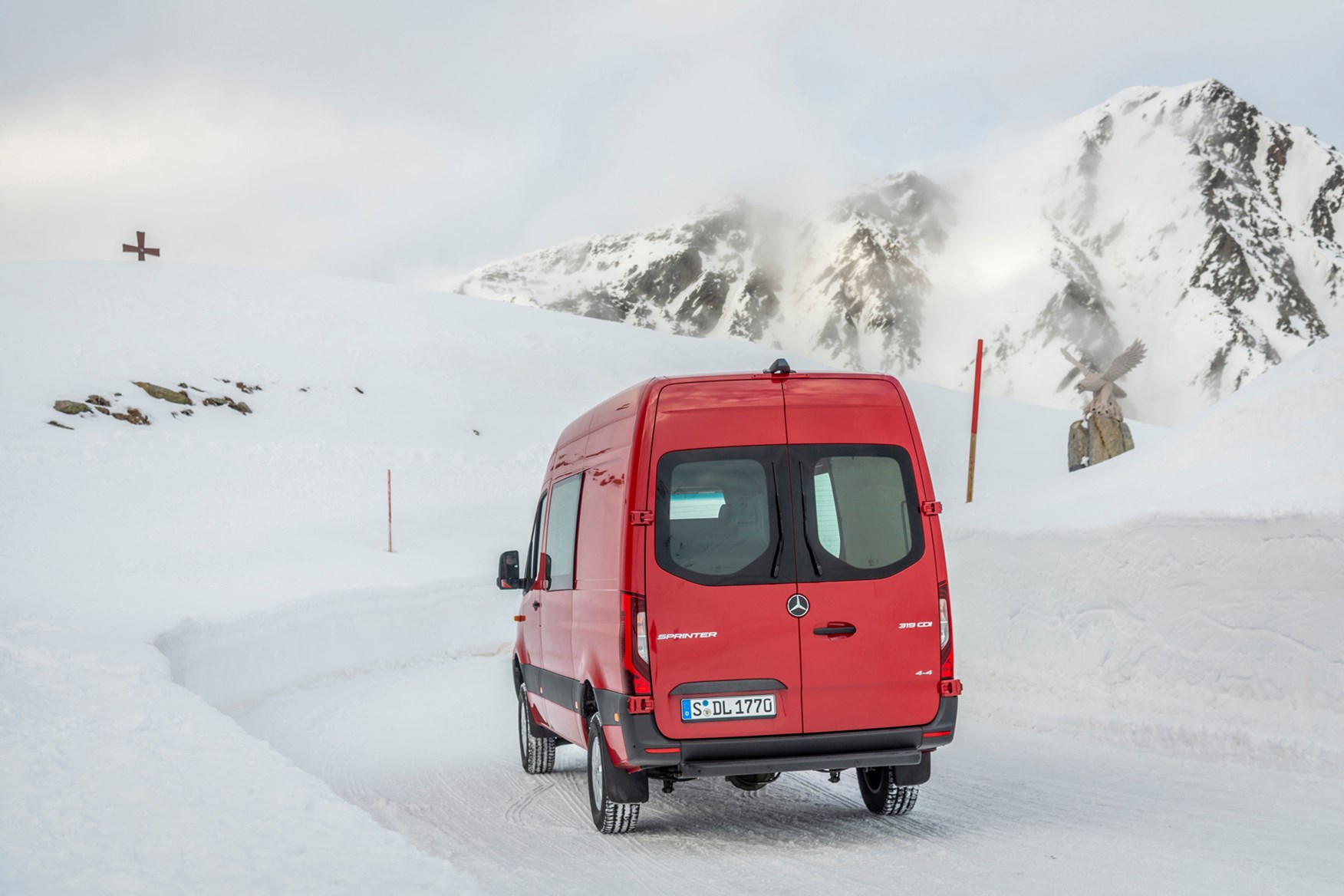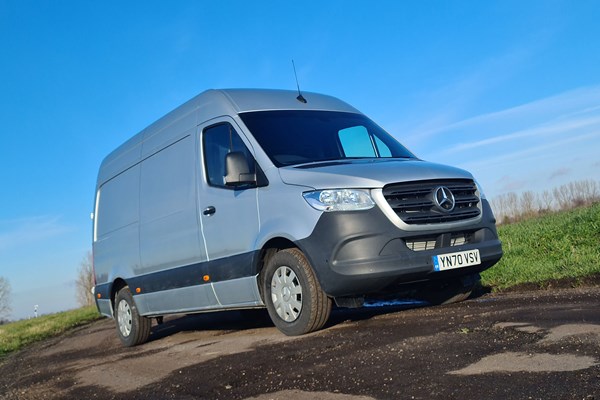Mercedes Sprinter van review (2024)
High-tech masterpiece sets new standards if you’re prepared to pay the price
PROS
- Very comfortable and easy to drive
- Comes in over 1,700 variants
- Now available with front-wheel drive
- Nine-speed automatic and 4x4 options
- Raising the bar for in-van technology
CONS
- Not the best for 3.5-tonne payload
- Rivals promise greater fuel economy
- Some issues with latest safety kit
- Refinement could be better
- So-so interior quality
Summary
The 2024 Mercedes Sprinter remains one of the most technically advanced, versatile and best large vans on sale. It might not be our current top choice in the class, but it has so much going in its favour that it is a fantastic choice regardless.
It's hugely reliable and covered by a three-year unlimited mileage warranty, making it great value, is the first Sprinter to be available with front-wheel drive, as well as rear-wheel drive and four-wheel drive, and it comes with a highly sophisticated MBUX infotainment system as standard. Safety levels are also very impressive.
In 2020, Mercedes also launched an electric version of the Sprinter, which was then updated in 2024 - you can read all about that model in our dedicated Mercedes-Benz eSprinter review.
Otherwise, keep reading to find out whether the diesel versions of this premium large van are the best choice for your business.
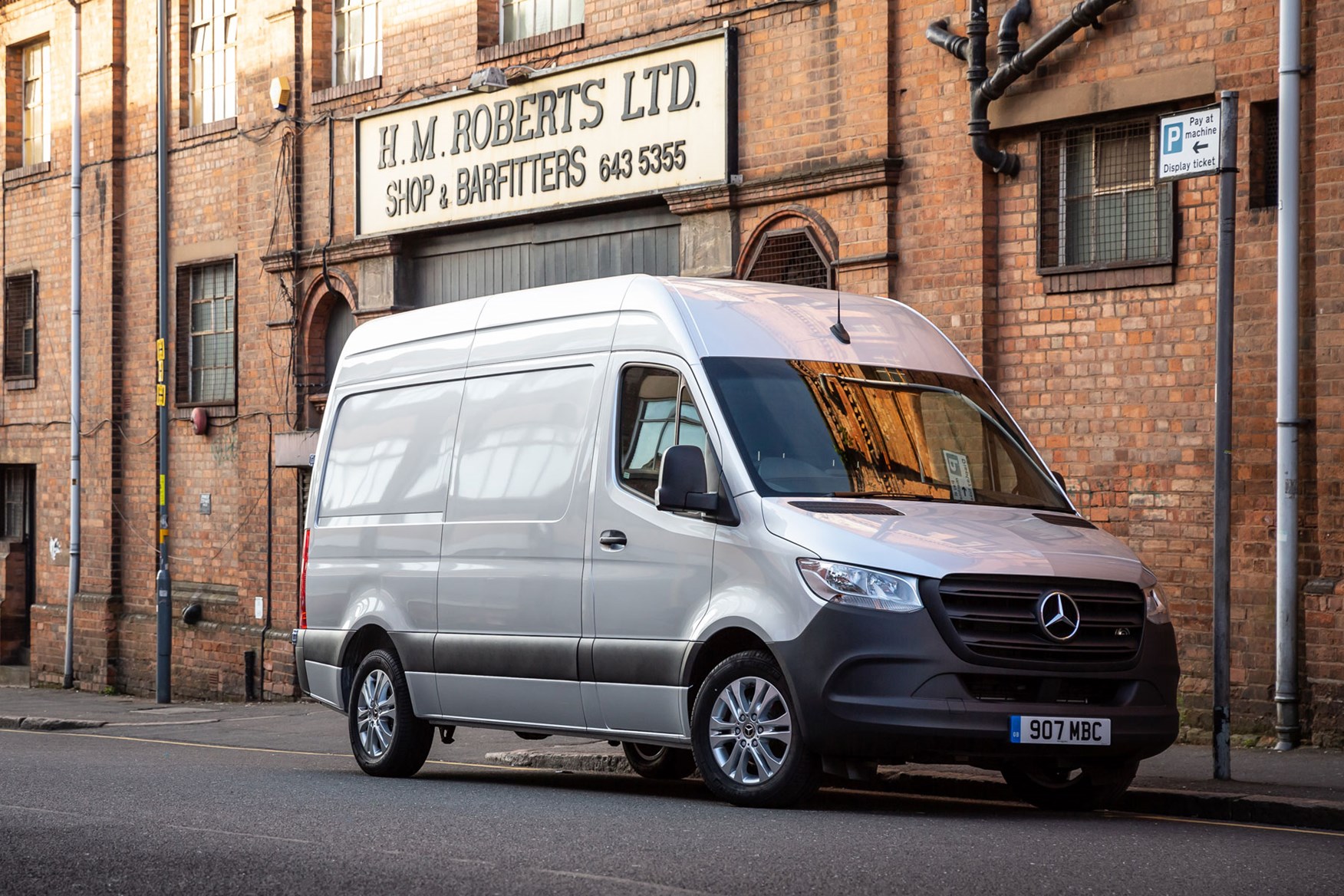
The Sprinter might not be the best selling large van, or the holder of the Parkers Award among its peers, but it continues to set the benchmark in some key areas. It's not top of the pile, as there are some areas where its rivals have the better of it, but no other van offers this level of technical sophistication, or such a huge amount of choice.
Over 1,700 variants
More than 1,700 versions of this Sprinter are available to order direct from Mercedes-Benz, while built-in Mercedes Pro Connect internet connectivity as standard in the UK is intended to make keeping track of your fleet – whether that’s one van or several hundred – easier than ever.
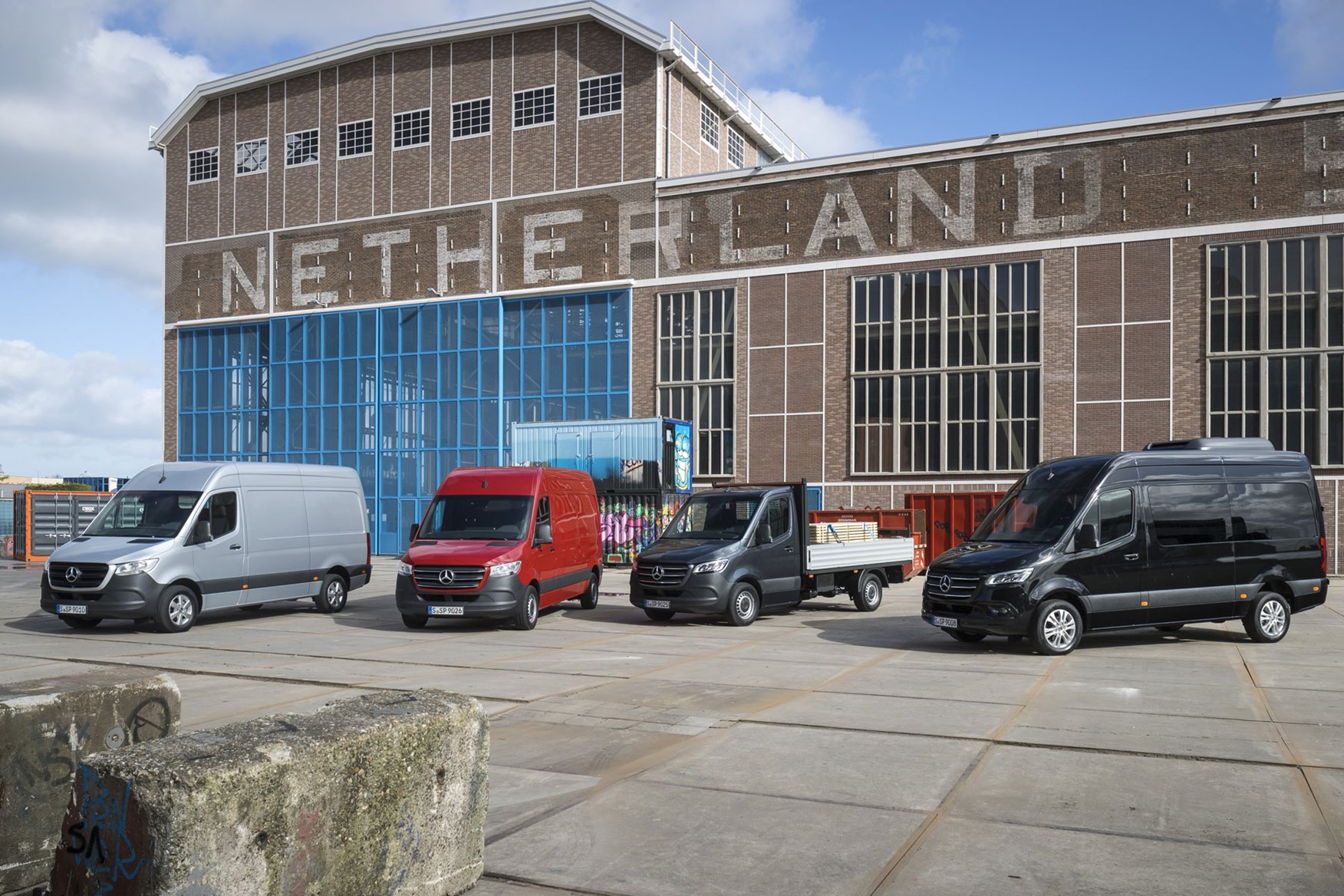
Improvements to the cab design bring greater comfort, increased practicality and enhanced durability. The very latest Mercedes MBUX infotainment system features supposedly time-saving sat-nav capability and a voice control function that works well within its limitations.
Safety equipment is similarly state-of-the-art. Though we have found that it doesn't always work quite as flawlessly as you'd hope.
Front-wheel drive available
Not only does this Sprinter panel van come in a choice of three wheelbase lengths, four body lengths, three body heights and load volume of up to 17.0 cubic metres, it’s also available with front-wheel drive (FWD). This is something that was new for this third-generation of Sprinter.
This is in addition to the rear-wheel drive (RWD) and all-wheel drive (AWD or 4x4) versions, rather than in replacement. So whatever your traction requirements, there should be a Sprinter to suit.
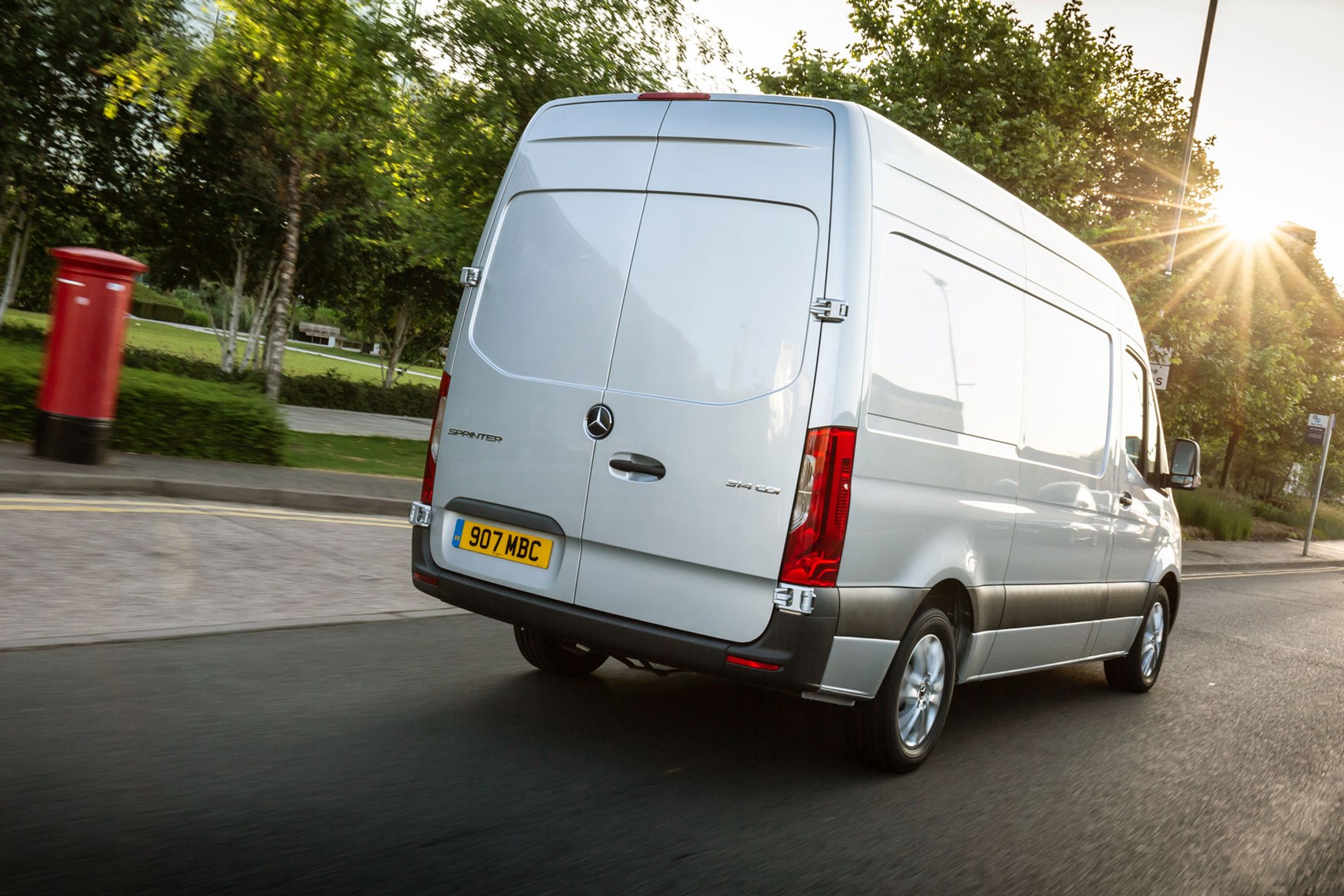
The major advantage to front-wheel drive Sprinters is an increase in payload, which goes up by 50kg compared with equivalent rear-wheel drive models.
But it also enables a lower loading sill height at the rear, additional body variants, and is available with an optional nine-speed automatic gearbox in place of the standard six-speed manual transmission. That was a first for a van at launch in 2018, though the rear-wheel drive Ford Transit is now available with a 10-speed automatic.
Mercedes Sprinter engines and body variants
Initially, most Sprinters of this generation were fitted with 2.1-litre turbodiesel engines of the same type used by the previous model – although as before, a 3.0-litre V6 turbodiesel is available at the top of the RWD range.
From mid-2020, a newer 2.0-litre engine design replaced a couple of the 2.1-litre options. Power outputs ranged from 114hp to 190hp, and torque output from 300Nm to 440Nm. As of 2024, the lower-powered versions have been dropped and the entry-level diesel is now a 150hp, which joins the 170hp and 190hp options. Torque has been slightly upgraded so the three now offer 340Nm, 400Nm and 450Nm respectively.
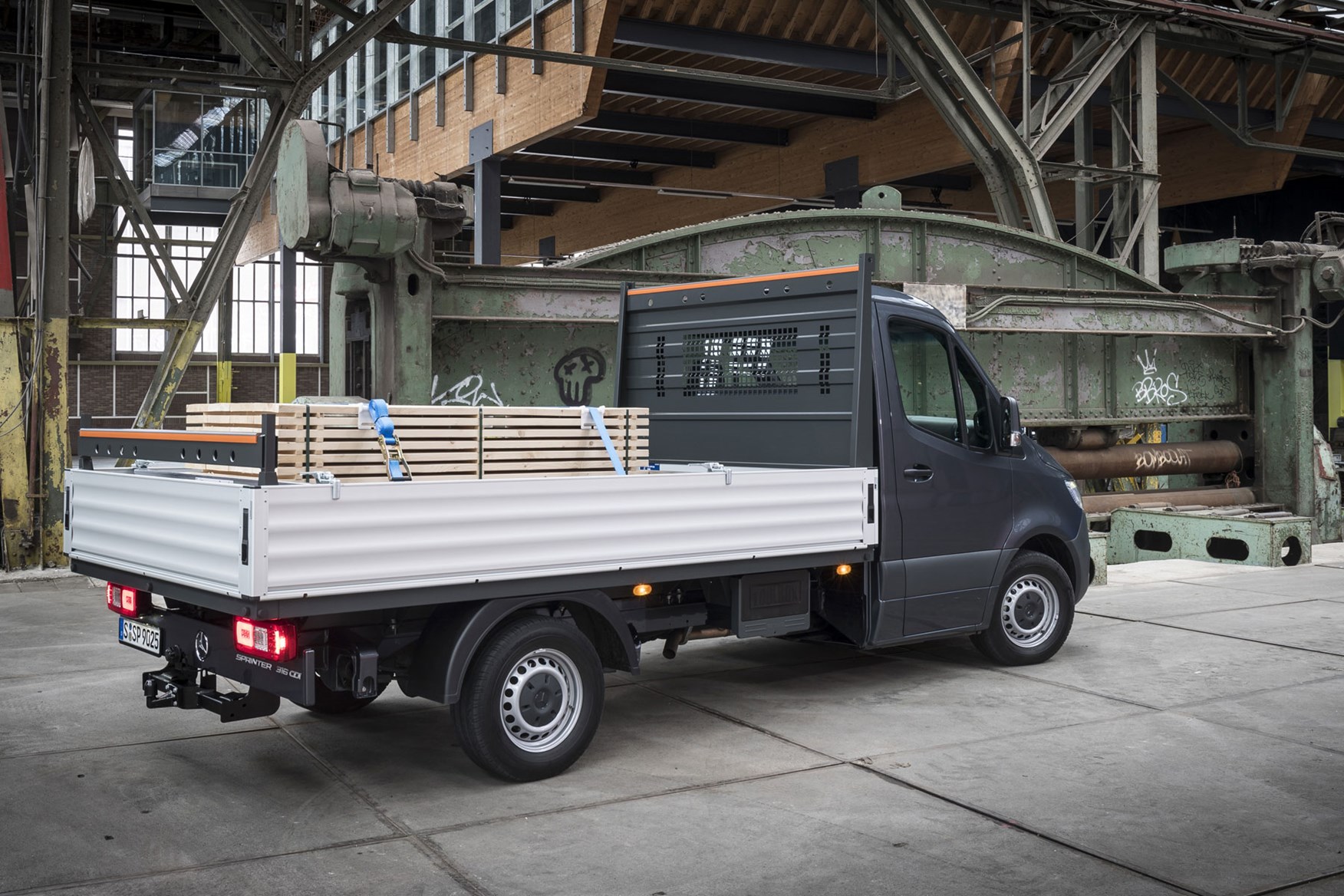
This review concentrates on the conventional diesel panel van, though we have also driven pickup and Tourer minibus Sprinters as well.
Other versions available direct from Mercedes-Benz include chassis cabs and a new tractor head made possible for the first time by the FWD layout, which should go down well with the campervan conversion market among others.
There is a Crew Van version available, too. This version offers seating for six in two rows and a payload of over a tonne that can be carried in what remains of the loading bay.
Mercedes Sprinter rivals
The Sprinter’s closest competitor is the Volkswagen Crafter. Up until this generation they were the same vehicle beneath the branding, making the rivalry between the two latest versions particularly intense.
We've a twin-test of the latest Sprinter against the latest Crafter so you can see how they compare directly.
The Crafter isn’t quite as high-tech as the Sprinter, but it is incredibly easy to drive, comfortable and cleverly designed. The MAN TGE is a rebranded version of the Crafter, and also worth considering, especially given the round-the-clock service available from MAN’s truck dealer network.
The Ford Transit is another key rival – supported by Ford’s extensive dealer network, the Transit sells in big numbers, and is also a smart, modern large van that drives very nicely for such a big vehicle. Its fantastic electric version took it ahead of the rest of its class.
We consider the Sprinter a class above the likes of the Peugeot Boxer and Renault Master families, which are getting very long in the tooth now, but 2024 brings updated or new versions for both.
The Iveco Daily works best if you need a van that goes up to an extremely high gross vehicle weight (GVW) – the Sprinter’s max is 5.5 tonnes, the Daily goes up to 7.2 tonnes.
The legal GVW limit for a regular car driving licence is 3.5 tonnes.
Verdict: is the Mercedes-Benz Sprinter any good?
Comfortable, easy to drive and well equipped as standard, the Mercedes-Benz Sprinter is a top choice of large van.
If you’re looking for the most high-tech solution on sale right now, this is it, though the VW Crafter and MAN TGE put a greater emphasis on the ease of use for the driver and the Ford Transit has a greater all-round offering with a better electric model.
The Sprinter does have an unmatched reputation for reliability, and there are no signs of this changing with this generation. The three-pointed star arguably represents the best possible brand image you can present to your customers, too.
However, refinement, payload and fuel economy aren’t necessarily top of the class, and as ever the Sprinter remains a pricey vehicle. Not that you’re likely to think it’s poor value, given what you get in return for your cash. Monthly finance costs can be highly competitive, too, thanks to its enduring popularity.
This Sprinter was runner up in large van category in the 2020 and 2021 Parkers Awards.
Skip to our full verdict on...
- Very comfortable to drive; great seats, bump-absorbing suspension
- Speed-sensitive electric power steering is clever but lacks feedback
- Front-wheel drive available with excellent nine-speed automatic
This generation of Sprinter is the first to offer front-wheel drive (FWD) in addition to rear-wheel drive (RWD) and all-wheel drive (AWD).
What's the Mercedes Sprinter like to drive?
Regardless of whether the engine is powering the front or back axle, the Sprinter’s driving experience is fundamentally the same.
Which is to say it’s characterised by very comfortable suspension (and not just for a van), giving a soft-feeling ride that irons out all but the worst road surface imperfections.
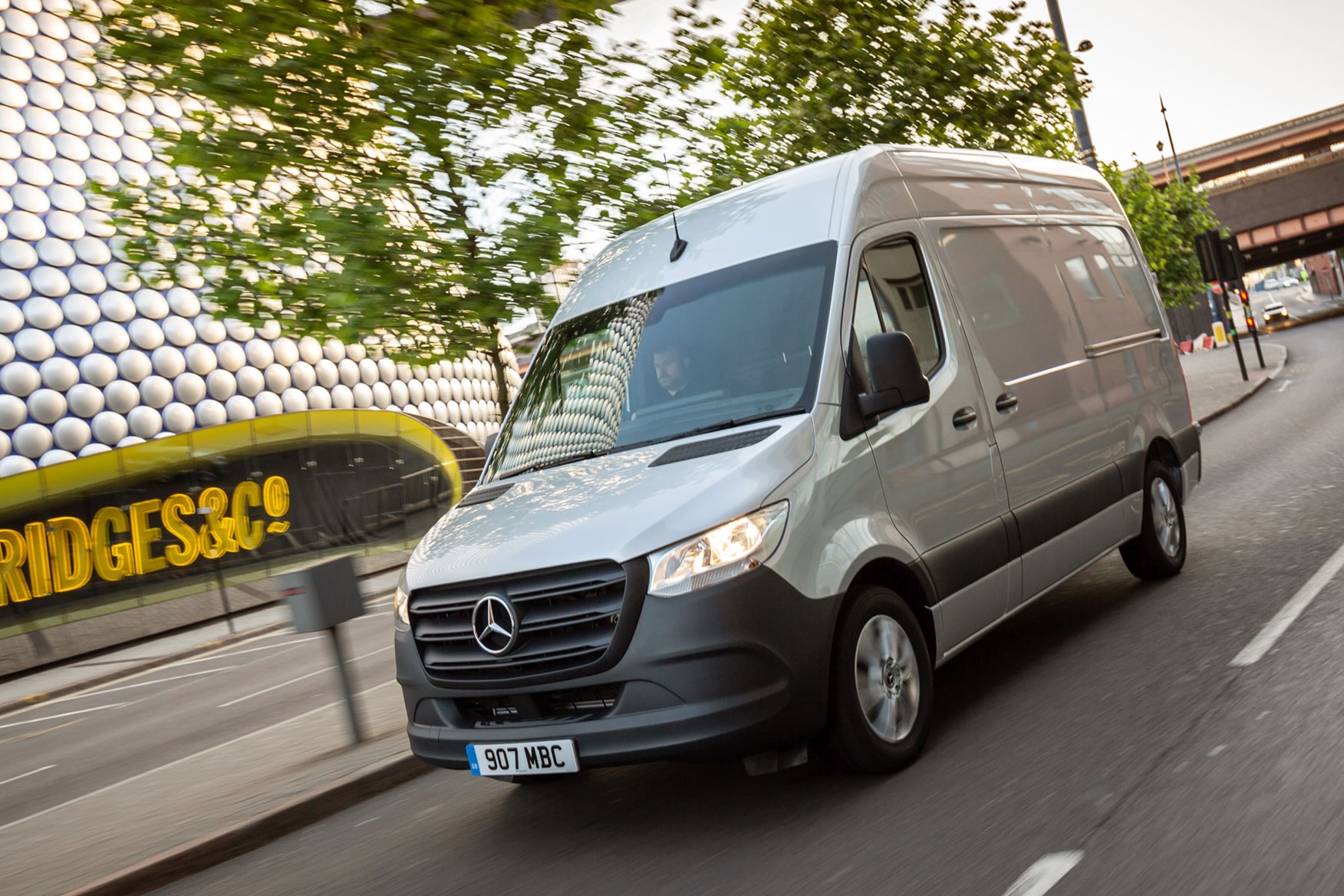
You can even add rear air suspension for extra comfort and control, or choose lightweight composite rear springs to replace the standard steel items for increased payload.
Put this together with some excellent seats, and it’s quickly clear that travelling long distances in one of these is unlikely to be a chore.
There’s not even much bodyroll in the corners, considering just how cushioning the suspension seems to be – and we say this having driven a variety of Sprinter van types with a variety of different loads in the back.
As such, when faced with a typical British B-road, the Sprinter proves surprisingly wieldy, allowing the driver to quickly build confidence in its handling and manoeuvrability. The suspension easily deals with mid-corner bumps, and over time you get used to the limited feedback from the electric power steering
Electric power steering – good and bad news
As with the VW Crafter, this Sprinter uses electric power steering assistance instead of the older hydraulic type because it’s more efficient – meaning it uses less fuel – and makes it possible to include some sophisticated safety systems that do some of the steering for you.
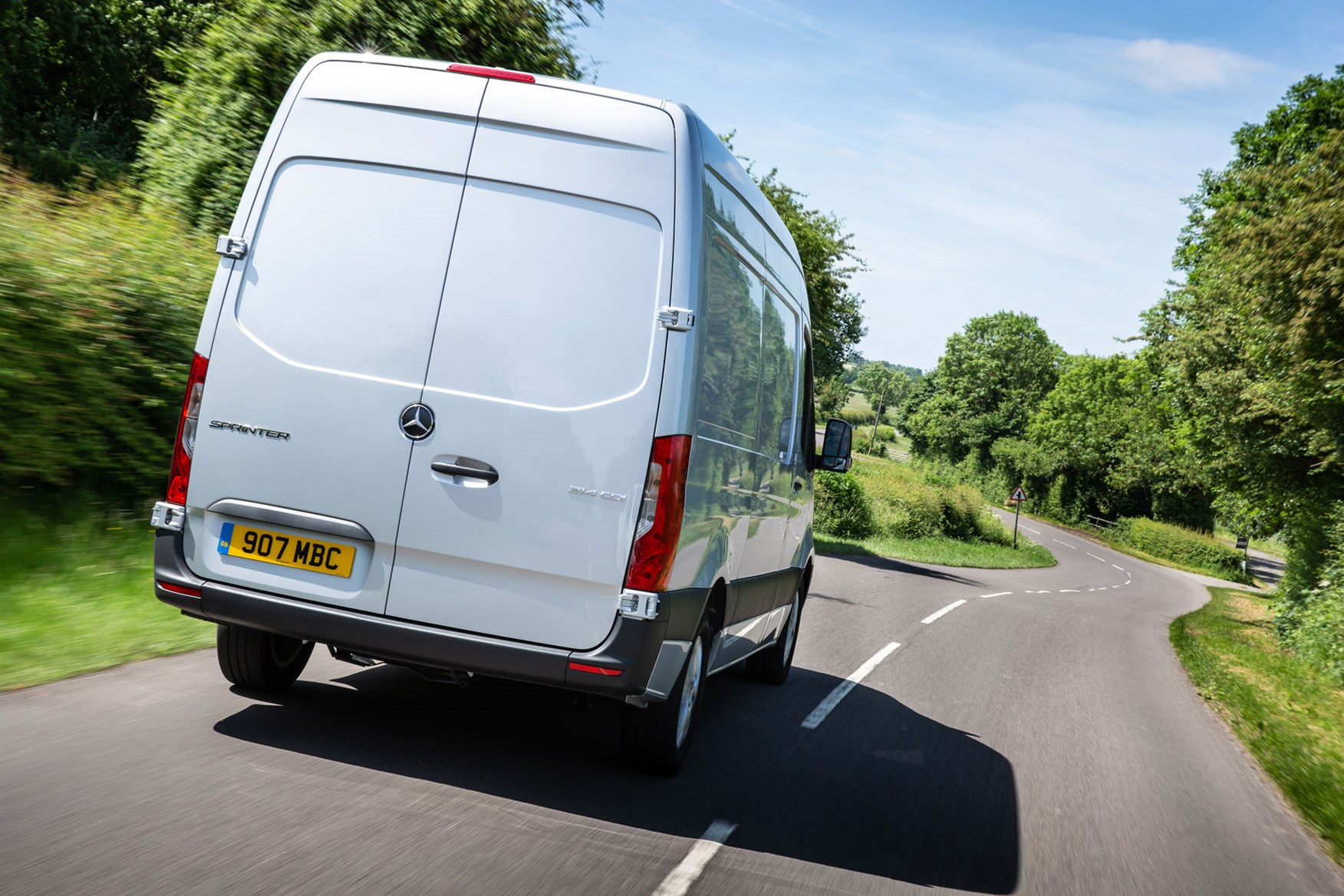
The electric power-assistance is fitted as standard (except on AWD models) and also speed-sensitive, so it gives you lots of assistance at low speeds for easy manoeuvring but reduces it as you go faster for greater stability. In theory.
On the plus side, it makes the Sprinter feel super-nimble around town – zipping through traffic is a breeze.
On the not-so-plus side, there is almost zero feedback, making it tricky to judge grip levels. And at motorways speeds the straight-ahead position is so vague you find yourself constantly sawing away at the wheel making micro corrections, which is rather tiring.
The Crafter’s steering is more reassuring and natural feeling in both cases.
Differences between front-wheel drive and rear-wheel drive Mercedes Sprinters
Beyond the increased payload and lower loading floor, the new-for-this-generation front-wheel drive Sprinters also seem to be more refined – the engines sound quieter and there’s less vibration in the cab, though still more than in some rivals.
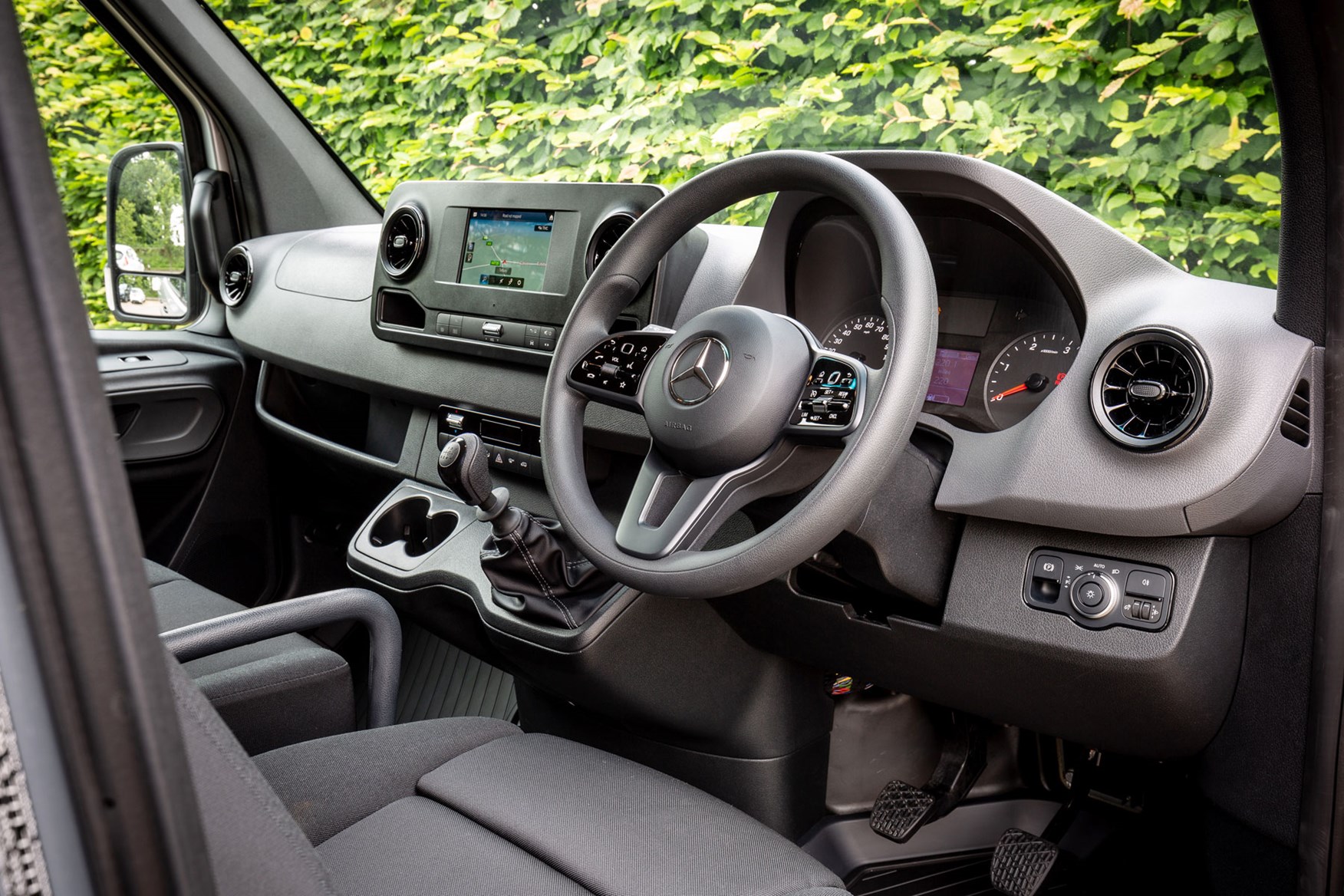
A six-speed manual gearbox is standard on all Sprinters, but the FWD unit is lighter to use where the RWD version sometimes requires a determined shove. Neither is particularly pleasant, however, and the drivetrains are at their best when combined with their optional automatic transmissions.
Again, though, the old seven-speed automatic (7G-Tronic) fitted to RWD Sprinters is out-classed by the superb smoothness and response of the brand new nine-speed auto (9G-Tronic) available in FWD models.
All of this leaves you wondering why anyone would bother with a rear-wheel drive Sprinter at all. But the RWD models remain better suited to the heaviest loads, as they offer increased traction and higher gross vehicle weights.
Which also explains why, at the time of writing in February 2021, the range in the UK has been cut back to just one front-wheel drive engine choice, down from the original three.
Mercedes Sprinter engines
With the addition of new 2.0-litre diesel engines in mid-2020, the Sprinter engine line-up presently split not just between front-wheel drive and rear-wheel drive (the 4x4 is special order), but also between Euro 6d-Temp emissions regulations and Euro VI emissions regulations for heavy duty versions.
Mercedes-Benz Sprinter FWD engine choice (Euro 6d-Temp):
- x14 CDI : 143hp @3,800rpm / 330Nm @ 1,200-2,400rpm
Mercedes-Benz Sprinter RWD engine choice (Euro 6d-Temp):
- x15 CDI : 150hp @ 3,800rpm / 340Nm @ 1,500-2,400rpm
- x17 CDI : 170hp @3,800rpm / 380Nm @ 1,600-2,400rpm
Mercedes-Benz Sprinter RWD engine choice (Euro VI):
- x14 CDI : 143hp @3,800rpm / 330Nm @ 1,200-2,400rpm
- x16 CDI : 163hp @ 3,800rpm / 360Nm @ 1,400-2,400rpm
- x19 CDI : 190hp @ 3,800rpm / 440Nm @ 1,400-2,400rpm
The x numbers refer to power output, while the x is replaced by another number that tells you the Sprinter's gross vehicle weight (GVW) - so a 214 CDI has a 3,000kg GVW, a 314 CDI has a 3,500kg GVW and a 514 CDI has a 5,000kg GVW, and so on.
At the moment, only the Euro 6D-Temp models use the newer 2.0-litre motor; the rest of the Sprinter range is still powered by the old 2.1-litre diesel - except the 190hp x19 CDI, which is a 3.0-litre V6.
Targeting operators more concerned with performance and strength than fuel economy, the V6 comes as standard with the seven-speed automatic transmission. It is noticeably smoother to drive than four-cylinder models, as well as being very fast.
V6 aside, the rear-wheel drive models are typically louder inside and transmit more vibration through to the cab and occupants, though this has improved somewhat with the newer 2.0-litre models.
These should also be particularly clean-running, as this is a very modern engine design that has been used in Mercedes' passenger cars prior to joining the van range. Performance-wise, though, there's little to separate them from the equivalent 2.1-litre models.
Previously there were two other front-wheel drive power-outputs to choose from: 112hp / 300Nm and 177hp / 400Nm, with the latter reserved exclusively for motorhome conversions.
For details of what the AWD Sprinter is like to drive, see the specific individual model review at the bottom of this page.
- Attractive yet functional design
- Standard UK equipment includes 7.0-inch touchscreen, keyless start
- Full details of MBUX infotainment and Mercedes Pro Connect telematics
While the outside of this Sprinter looks only slightly different to the model it replaced, inside the cab a much more thorough transformation has taken place.
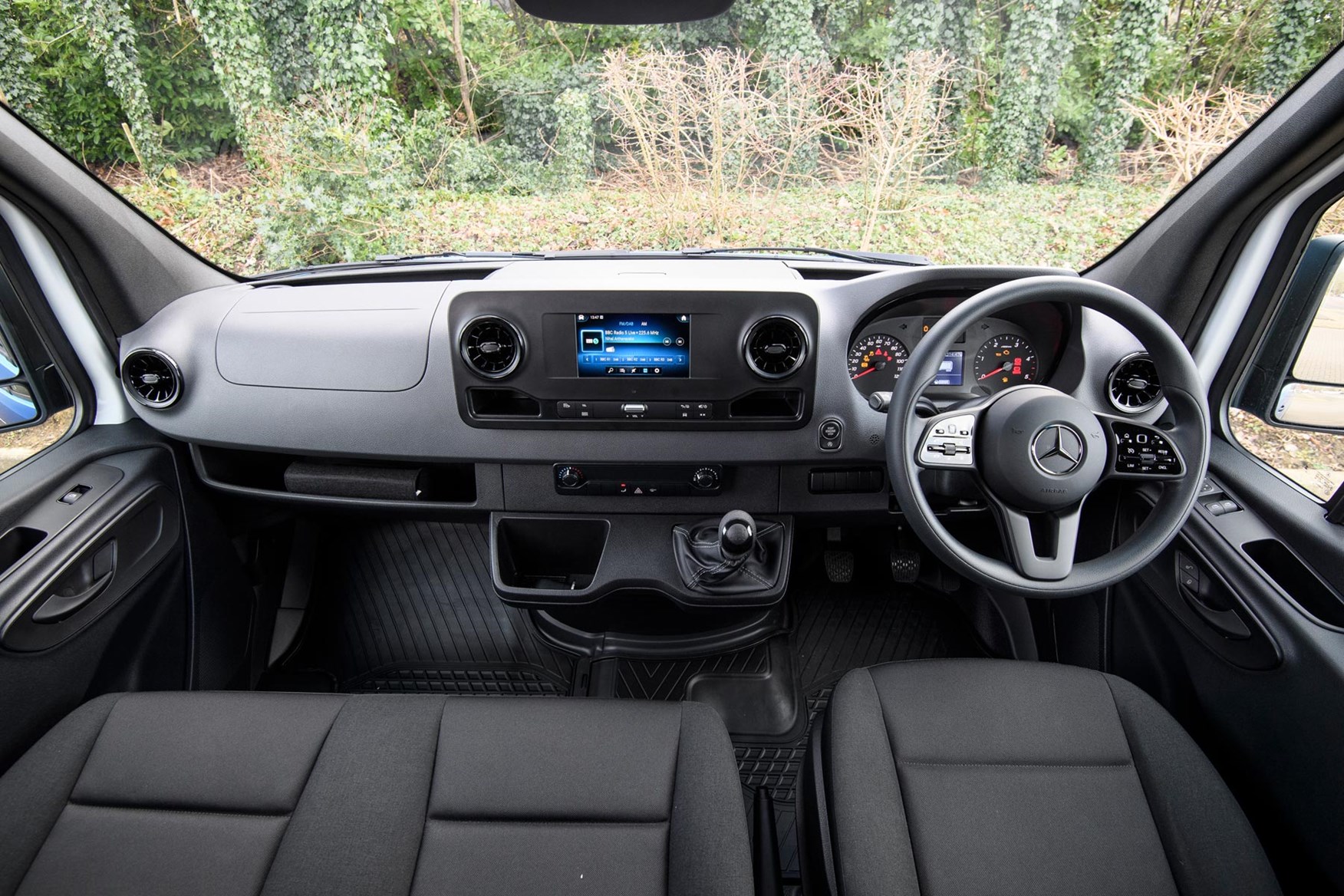
Gone is the slab-like dashboard of the previous Sprinter, in its place a sleek, rounded design with a built-in central touchscreen, housing the latest MBUX infotainment system (on which more below).
Every diesel Sprinter sold in the UK comes with the basic 7.0-inch version of this screen – unless you specifically ask Mercedes to remove it – with an even bigger 10.25-inch touchscreen available. The basic model doesn't feel or look as premium as the higher-end version and some of the newer rivals on the way. There is little difference in functionality between the two though - the bigger screen upgrade makes the MBUX system easier to use, but everything still functions as it should without this.
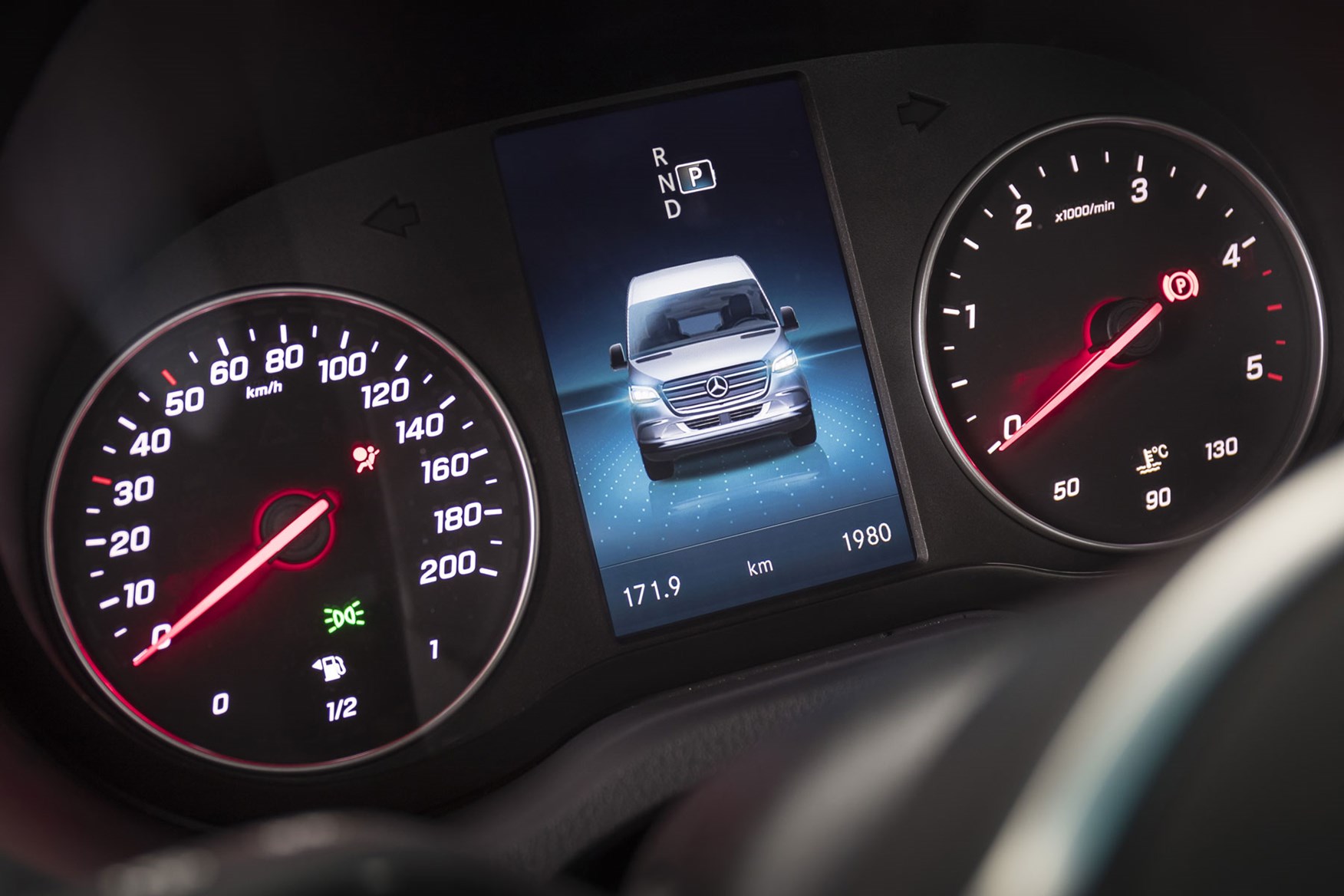
The steering wheel features a large number of buttons plus touch-sensitive pads for controlling the screen on one side and scrolling through the menus in the instrument cluster on the other. These take a little getting used to, but fundamentally work as they should.
The dials are clear on more basic versions, while fancier models add a full colour trip computer module in the middle, further increasing the premium ambience.
Best-in-class quality?
The Sprinter’s swoopy dashboard looks impressive at first glance, and elements of it are very high quality. Details such as the air vents and control for the optional air-conditioning seem almost unnecessarily good.
However, the dashboard itself feels a little cheap and less well put together than an equivalent VW Crafter. On one test van, the lid for the central dash-top storage bin kept popping open as we were driving along, something that quickly became rather annoying.
Still, if you weren’t sitting so high up, with such a commanding view of the road ahead, you could easily pretend you were driving a car. Picking up clients and customers in this van should not be an issue.
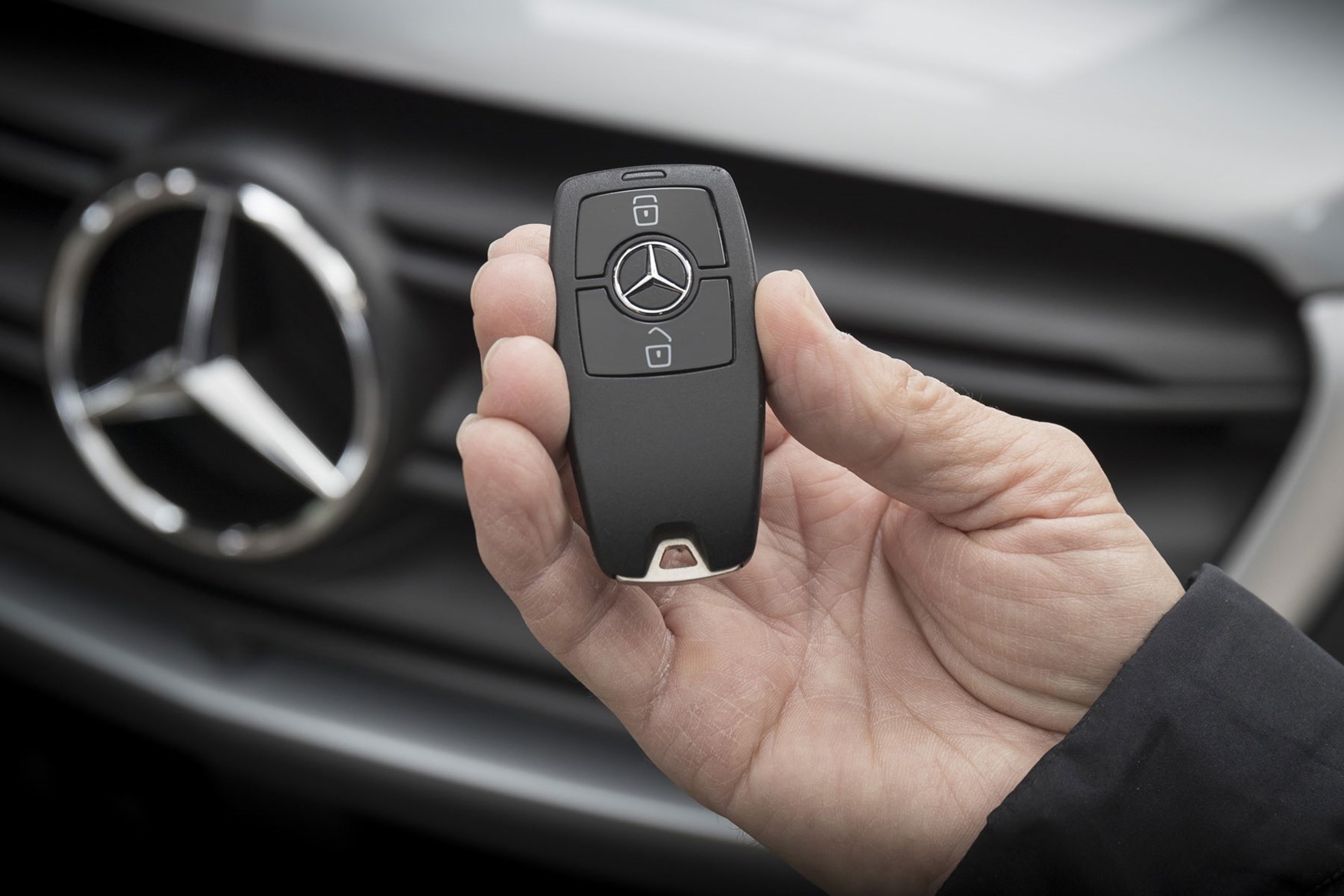
Every Mercedes Sprinter comes with keyless entry and start as standard, meaning you can keep the key in your pocket at all times (unless you need to recharge it, which can be done by a special slot in the bottom of the centre console).
How good are the seats in the Mercedes Sprinter?
Simply put: excellent.
The higher-specification seats are so comfortable and supportive they actually feel like they’re doing you some good – as if you might get out of the Sprinter after a long journey with better posture than you started with.
The entry-level seats aren’t quite as adjustable, but again comfort and support are a cut above the norm, though the VW Crafter is also very good in this area.
The Sprinter’s seats are designed to be easy to get in and out of; a surprisingly useful feature if you’re a multi-drop driver such as a parcel courier.
Is there a lot of storage space inside the Mercedes Sprinter?
Mercedes has made the storage solutions inside the Sprinter's cab highly customisable, far more so than with any rival.
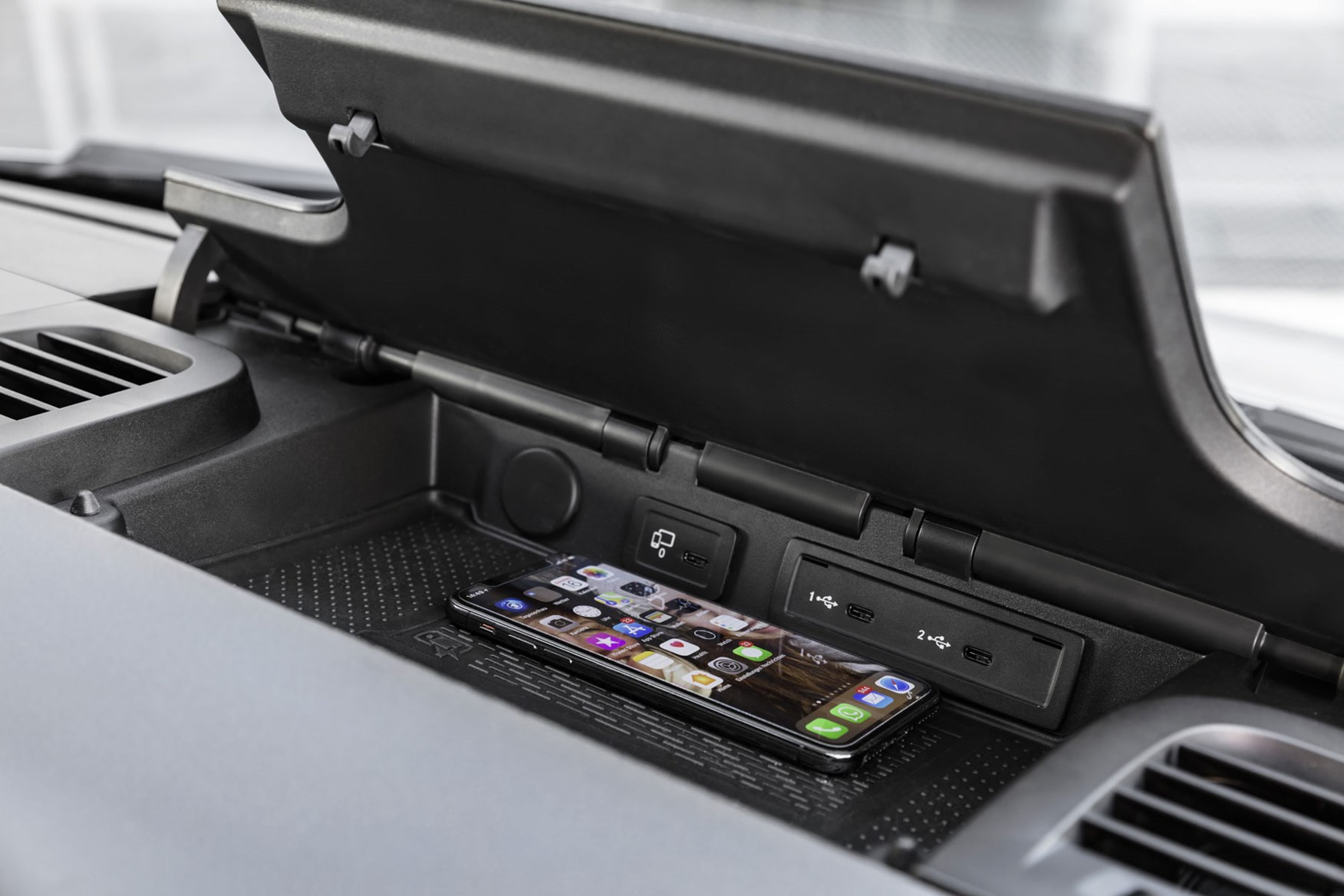
The trio of dash-top trays are available with or without lids (and even without you can have a lip at the back to stop stuff flying out), while the gear lever pod on manual transmission vehicles can be accompanied by a dual cupholder (one side being smaller than the other, as if designed specifically to hold energy drink cans) or a simple cubby hole.
In Sprinters equipped with an automatic gearbox – controlled by a stalk near the steering wheel rather than a more common lever – you can have two of these storage areas, to mix or match. Or you can elect to not have them at all, increasing the knee room for the middle passenger if you regularly carry one.
There’s more storage overhead, including a DIN slot, should that be required for a tachograph or other equipment. Multiple USB connections and other power sockets are available as required. Under-seat storage is present and correct.
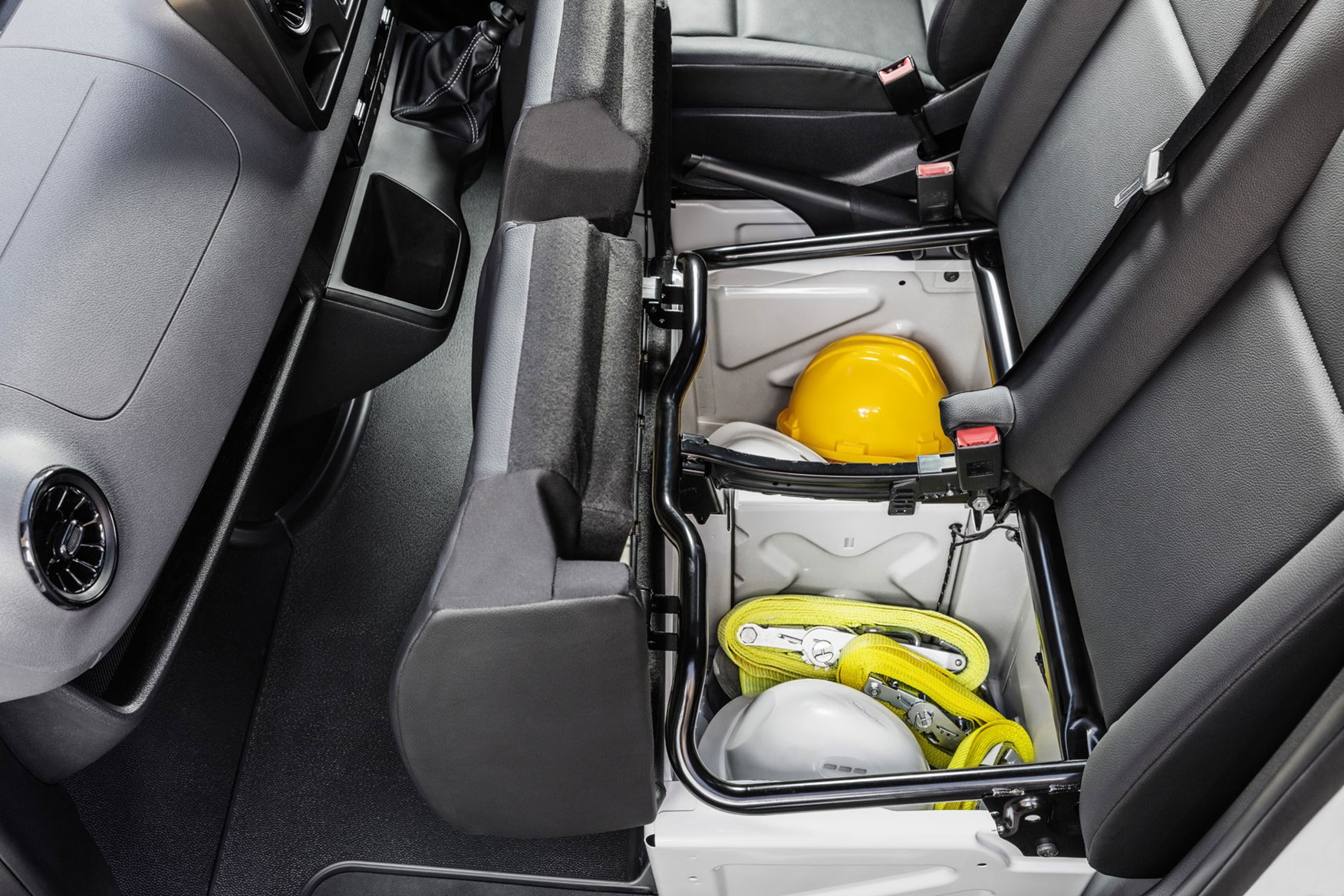
However, it’s not all good news. There’s no conventional glovebox at all (though a small shelf is offered on some versions), and the dash-top trays go so far back towards the screen it can be difficult to reach things inside.
Taken as a whole, we're not sure the Sprinter stacks up that well inside against the latest VW Crafter (or MAN TGE). The Volkswagen not only comes with a conventional glovebox, it also offers a third, easy-to-access compartment in the doors and has a surprisingly handy shelf that runs across the entire width of the cabin
The Crafter also appears to be made from better quality materials. So while the Sprinter offers the more flexible solutions (including greater numbers of lids on things), we'd examine both German rivals carefully to see which best meets your in-cab storage needs.
What is the Mercedes MBUX multimedia infotainment system like?
MBUX stands for Mercedes-Benz User Experience, and it replaces the old Comand infotainment system, featuring not only a slick touchscreen display, DAB radio (for the first time in a Sprinter) and Bluetooth as standard, but also a ‘real speech’ voice control system, similar in function to Siri on an iPhone or Google Assistant on an Android phone.
Simply say ‘Hi Mercedes,’ and the system will reply ‘How can I help you?’
You can then ask it a question or tell it to do something. Its capabilities are a little more limited than a smartphone's, and it can be quite laggy, but it can answer questions about the weather, change the orientation of the sat-nav display (where nav is fitted), and if you’ve got your phone connected, you can dictate text messages very easily.
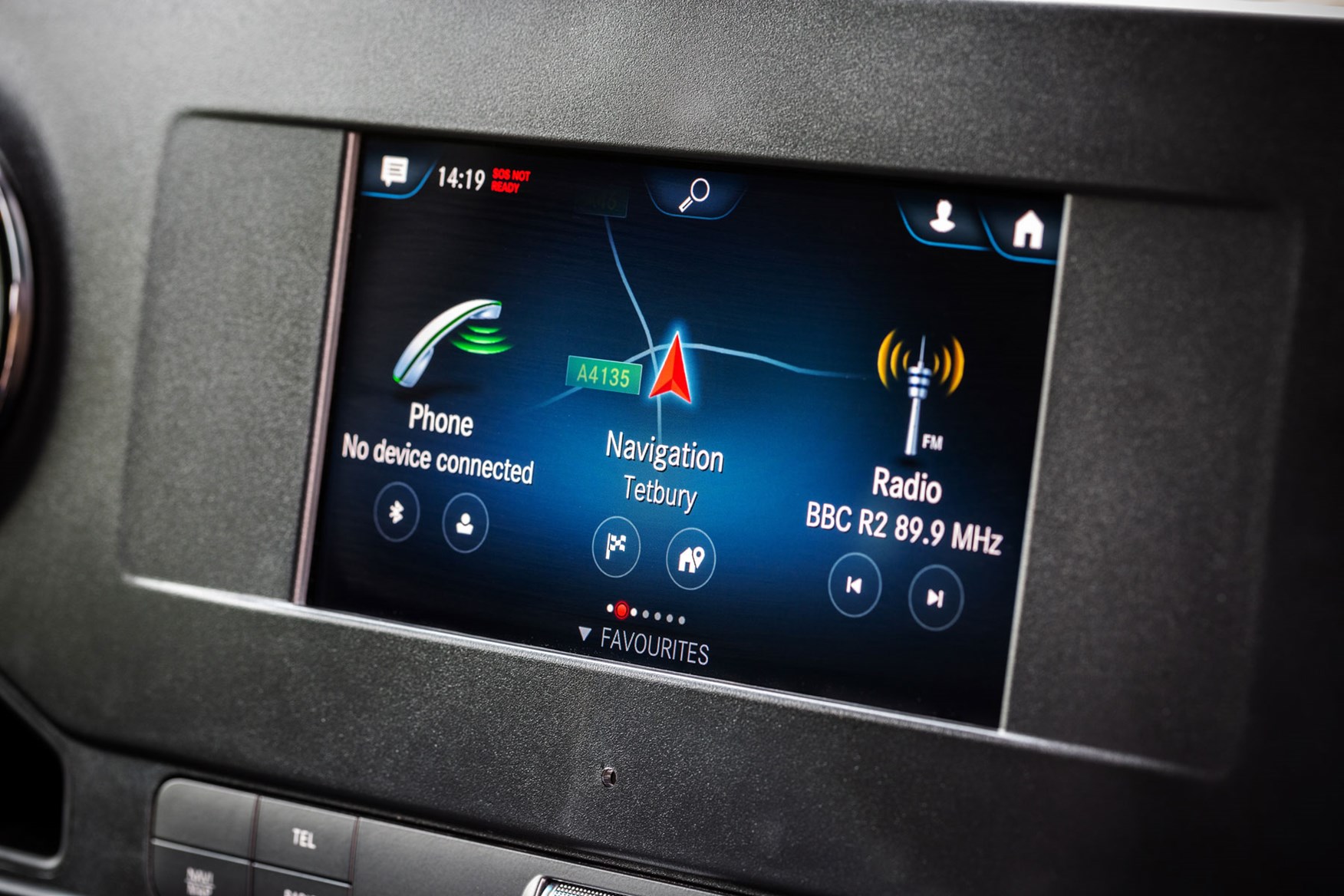
Ok, so in the demo in the press conference at Sprinter's international launch it got confused between the words ‘new’ and ‘nude’, which could have potentially interesting consequences, but fundamentally it works very well.
We were surprised that asking ‘Where are we?’ didn’t get any response at all, however, and although it's supposed to be able to turn up the heating on command we couldn't get this to work.
It does seem to know more immediately practical things like speed limits, though.
Other useful features within the MBUX system include the ability to pair more than one phone at a time, and to set driver profiles.
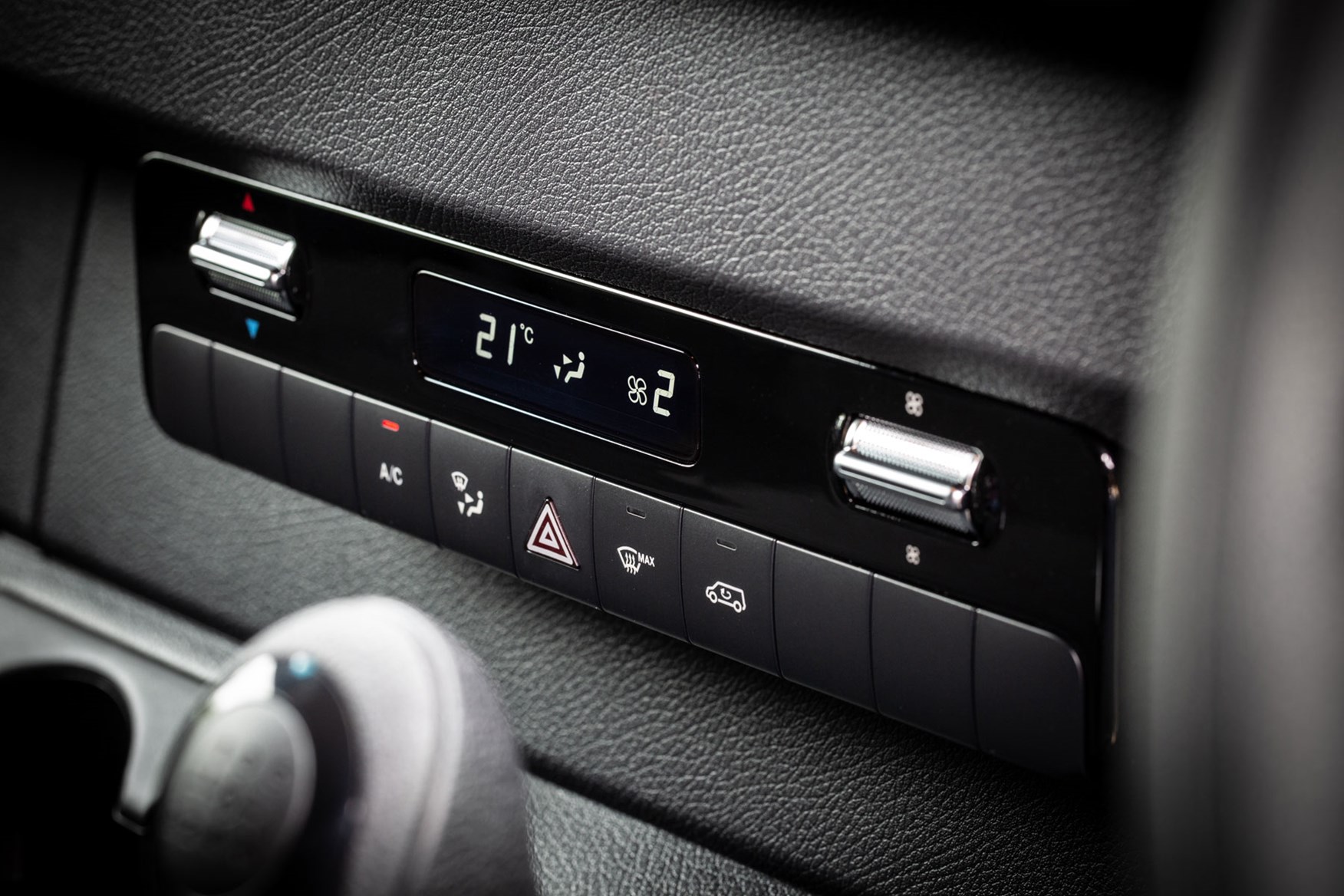
This last feature is handy as the system also learns which of its features you use most often, and tailors itself to suit. If lots of drivers use the same van, they will no longer be frustrated at other people’s choice of radio station, for example.
Mercedes Pro Connect in the Sprinter
Every Sprinter of this generation comes fitted with 4G Wi-Fi internet connectivity as standard – which is how many of the MBUX functions work.
However, this also allows the van to be integrated into the Mercedes Pro Connect telematics system right out of the box.
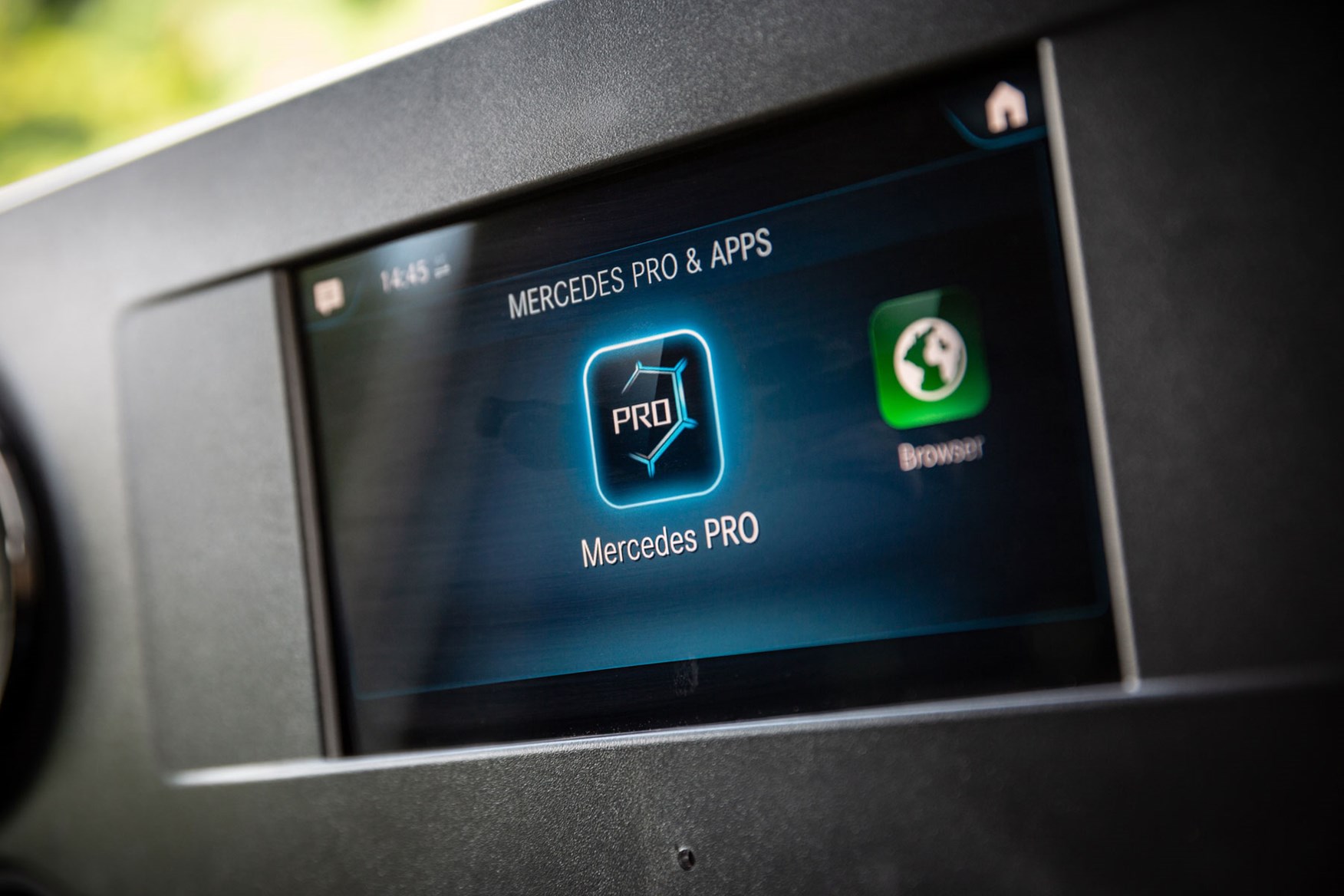
Telematics on vans is nothing new, but up until this point it has mostly relied on software (and hardware) from other companies. Mercedes is the first manufacturer to bring its own to market, and is offering eight packages at launch with the intention of making it as easy as possible to keep a fleet of Sprinters running smoothly while also improving the efficiency of your business.
As such, functions range from basic info about the van itself – including fuel level, tyre pressures and whether the doors are locked – to vehicle operations and management tools. All controlled via smartphone app or computer.
- Increased level of standard equipment, long service intervals
- Reduced running costs through intelligent design, high residual values
- Fuel economy still doesn’t match the very best in class
The Sprinter is not the cheapest van to buy, but the promise of strong secondhand values means monthly finance payments may be more affordable than you’d think – so don’t immediately rule Mercedes out based on the list price.
Also, if you consider what you’re getting for your money, it really represents very good value.
Mercedes Sprinter mpg
According to the latest WLTP standard, the Sprinter's official fuel economy figures range from 29.1mpg to 32.1mpg for the Euro 6d-Temp models; at the time of writing, Mercedes is yet to publish WLTP figures for the heavy-duty Euro VI versions.
You might expect the front-wheel drive models to have a clear fuel economy lead, but on paper there are rear-wheel drive versions with the new 2.0-litre engine that exactly match the best FWD variants.
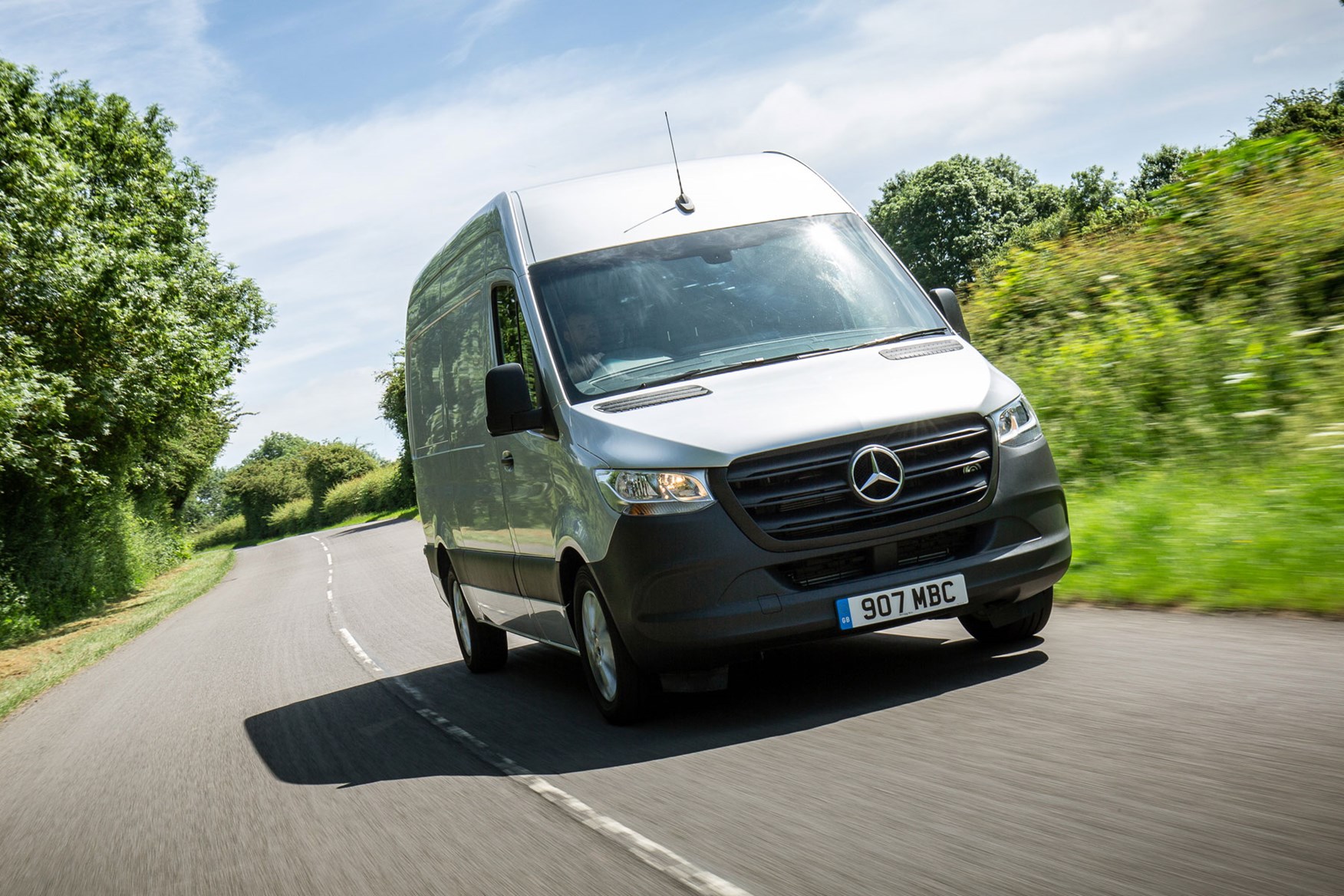
Out in the real world, Mercedes claims FWD with the nine-speed auto will be particularly efficient, but as with every van much will depend on how you drive and how heavily you're loaded. Expect mid-20s mpg, in general.
Mercedes Sprinter running costs
The automatic gearboxes, though more expensive in the first place, should reduce wear-and-tear costs over time, as they prevent drivers from being too aggressive with clutches and other components.
Mercedes-Benz servicing and parts aren’t known to be the cheapest, but the firm does offer a line of reconditioned parts at lower prices, and for this model has worked hard to make it easier to replace individual components rather than entire assemblies.
Buyers also get first-rate emergency breakdown assistance known as MobiloVan. This is free for up to 30 years, as long as you continue to get the van serviced by an official Mercedes centre – saving you the cost of additional breakdown cover, which may make up for paying a little more for the service itself.
Mercedes Sprinter servicing intervals
FWD Sprinters require servicing every 24,000 miles or two years – whichever is sooner.
RWD Sprinters can go up to 37,000 miles between services.
In practice, the Mercedes Pro Connect system can advise you of upcoming service and maintenance issues well ahead of time, which means you can arrange to get the work done when it’s least inconvenient, minimising downtime and optimising efficiency.
Mercedes Sprinter warranty
All Mercedes-Benz Sprinters are covered by a three-year, unlimited-mileage warranty.
Mercedes Sprinter standard equipment
When originally launched in 2018, this Sprinter was available in a single version - though with more standard equipment than you'll find in the rest of Europe - supplemented by an enormous options list.
The enormous options list remains, but as of mid-2020, Mercedes-Benz Vans UK now offers the Sprinter in a choice of three trim levels: Pure, Progressive and Premium.
The Pure model is only available as an entry-level package with light-duty front-wheel drive vans powered by the 143hp 2.1-litre engine and limited to 3,000kg gross vehicle weight. The worst thing about this, however, is that it comes with a fixed steering wheel position, rather than an adjustable one.
Mercedes Sprinter Pure standard equipment highlights:
- MBUX 7.0-inch touchscreen infotainment system with Wi-Fi, DAB, Bluetooth, USB-C connection, Apple CarPlay and Android Auto
- Keyless start
- Cruise control
- Multifunction steering wheel
- Dual passenger seat
- Full-width partition bulkhead
- Plastic floor covering
- Head-insulating glass
- Headlight assistant
- Double locks
- Integrated connected alarm system
Mercedes Sprinter Progressive standard equipment highlights (in addition to Pure):
- Extra USB-C socket
- Adjustable steering column
- Height and rake adjustable steering wheel
- Driver's armrest
- Lidded dashtop storage
- Wooden flooring
Mercedes Sprinter Premium standard equipment highlights (in addition to Progressive):
- Air-conditioning
- Driver's comfort seat
- Upgraded seat trim
- Front grille frame in body colour
- Parking package (including reversing camera and Parking Assist)
- Full wheel trim covers
You'll see that none of them come with the fancy sat-nav as standard, and that only Premium includes air-conditioning.
- The most reliable van on sale
The Mercedes-Benz Sprinter has long been the van with the best reputation for reliability, repeatedly coming top in the FN50 van reliability survey.
There seems to have been no change to this outstanding performance with the introduction of the 2018-onwards model. If you want a reliable van, the Sprinter should be your first port of call.
However, as we stated earlier, nothing is perfect - and this generation of Sprinter (known internally at Mercedes-Benz as the 907) has been subject to quite a few safety recalls.
Official safety recalls
Check this Sprinter out in the UK government official vehicle recall website, and you'll find that 2018 models were subject to quite a long list of recalls. Most of these only impacted a small number of vans, though, and appear to be mostly teething issues related to building the new model (2018 was its first year of production).
This suggestion is supported by subsequent years having far fewer recalls. Although the most serious-sounding recall of the lot relates to wheelarch liners potentially damaging brake lines, and the UK recall for this only involves nearly 39,000 Sprinters, built right up to 2020.
It's a big seller, too
Still, Mercedes does sell a huge number of Sprinters - it's often the second bestselling van of any type in the UK, for example. So for it to still have such a high reputation for reliability speaks volumes about how well it performs for customers.
The unlimited mileage warranty speaks of the company's confidence, too, while free MobiloVan roadside assistance is available for up to 30 years, as long as the van is serviced by Mercedes.
- Cutting-edge safety equipment – both standard and optional
- Autonomous braking systems are a bit keen…
- Built-in connectivity increases peace of mind security
Another area where Mercedes has really gone to town with this Sprinter is safety.
Mercedes Sprinter safety
This ranges from features such as the rain-sensing Wet Wipers – which squirt washer fluid from the blade rather than onto the windscreen from jets on the bonnet in an effort to reduce the amount washing the screen obstructs your view (it works very well) – to cutting-edge active safety systems designed to reduce accidents.
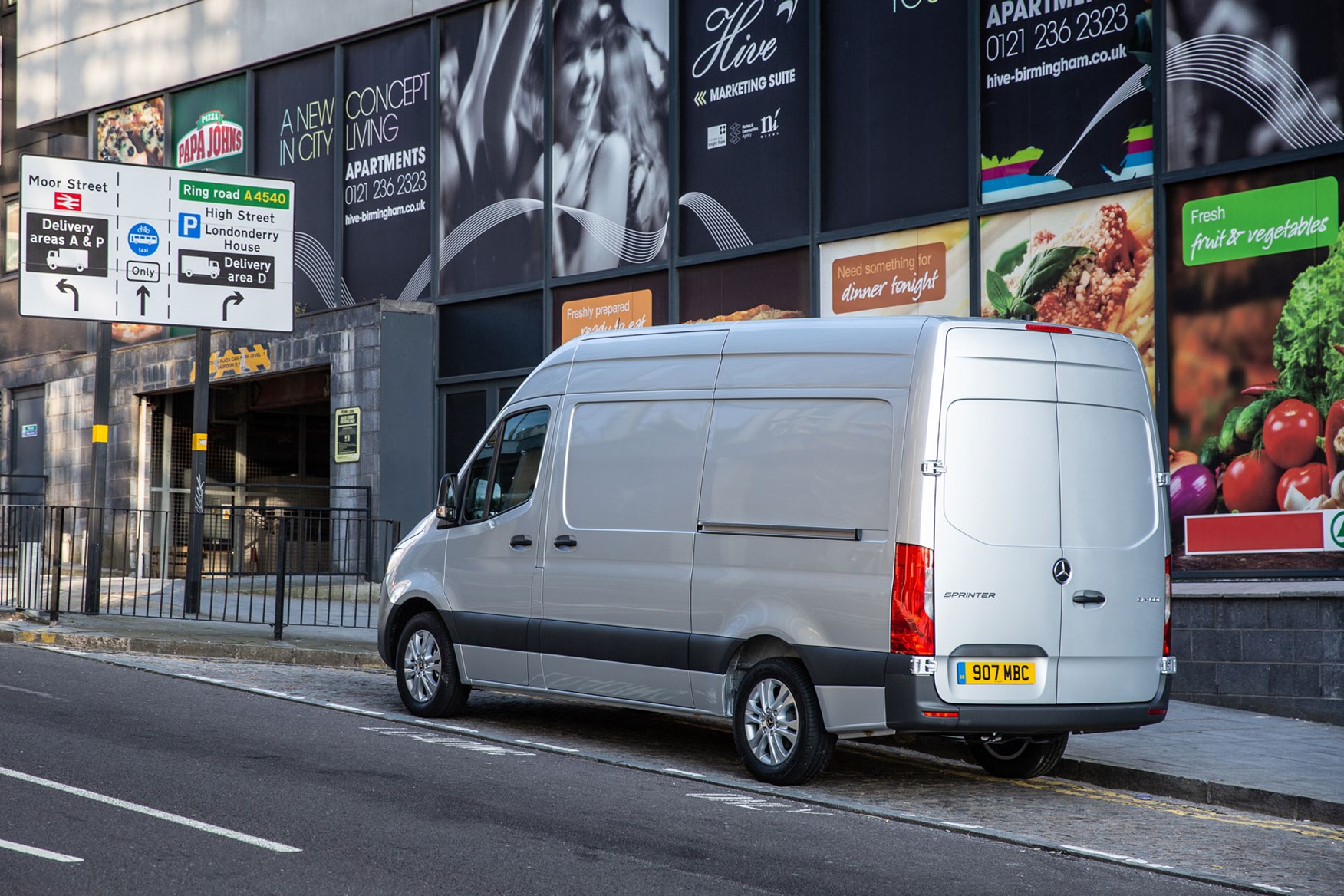
Standard features include load-adaptive electronic stability control (ESC – known as ESP by Mercedes) and Crosswind Assist, which now uses the steering as well as the brakes to counter side winds that might otherwise blow you off course.
UK Sprinter buyers also get Active Brake Assist – an autonomous emergency braking (AEB) system that now detects pedestrians and works better at night – and driver-monitoring Attention Assist as standard as well.
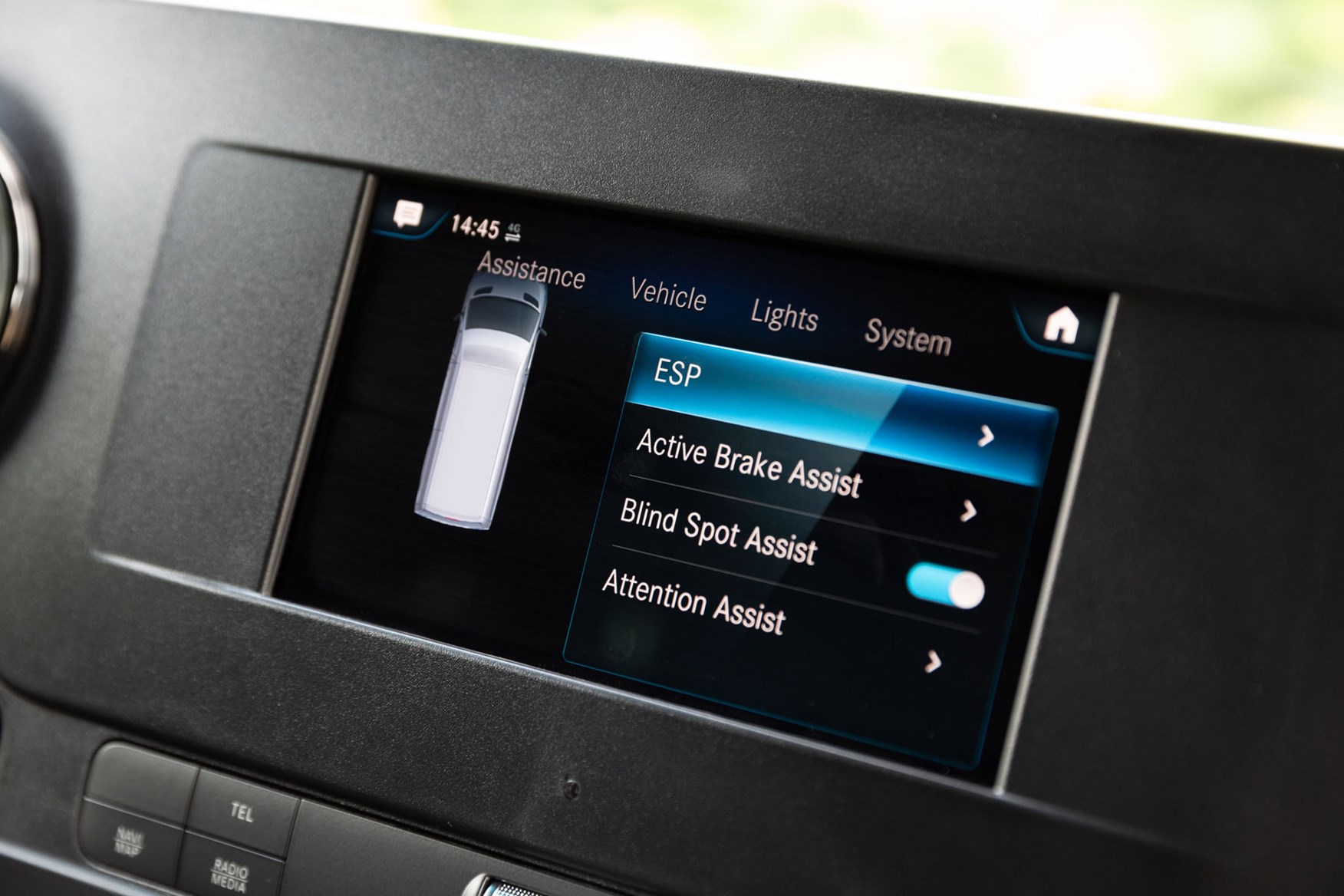
Optional safety upgrades include:
- Active Lane Keeping Assist – warns then brakes one side of the van to prevent you leaving a lane without indicating; quite aggressive to say the least, see below
- Active Distance Assist Distronic – an adaptive cruise control system with stop and go capability, meaning it will bring the van down to a standstill in traffic, and restart it if the traffic begins moving again within three seconds, taking the pain out of jams
- Parking Package – all-round parking sensors plus self-cleaning reversing camera
- Drive Away Assist – combined with the Parking Package, this stops you driving into things by accident from a standstill
- Parking Package with 360-degree camera – birds-eye view camera system for the ultimate in avoiding objects at low speed; available on cars and some pickups for years, it's great to see it appearing more widely on vans
- Blindspot monitors
- LED headlights
Phew.
Should you still manage to have an accident, the Sprinter can automatically call the emergency services, bringing them to your aid.
Autonomous braking systems still need some work
All these safety systems are great – if they work properly. But on the initial launch drive of the 2018-on Sprinter, we found some of the braking functions a touch too aggressive.
The Active Lane Keeping Assist was particularly bad, slamming the brakes on if you wandered too close to a solid white line when going round a curve. A shock to us; an even bigger shock to the vehicle behind.
Similarly, the main Active Brake Assist triggered itself – albeit more gently – apparently in response to a shadow from a bridge. This was only a momentary ‘false-positive’ so we didn’t end up at a standstill in the outside lane of a Dutch motorway, but it was disconcerting, nonetheless.
Euro NCAP Silver award
In December 2020 Euro NCAP launched a van safety campaign, naming the best and worst vans for safety according to their available safety equipment. The Sprinter was rated Silver.
Mercedes Sprinter security
An alarm and immobiliser system are fitted as standard, while keyless entry and start on all models means you never need to take the key out of your pocket – which hopefully reduces the chance of you losing it.
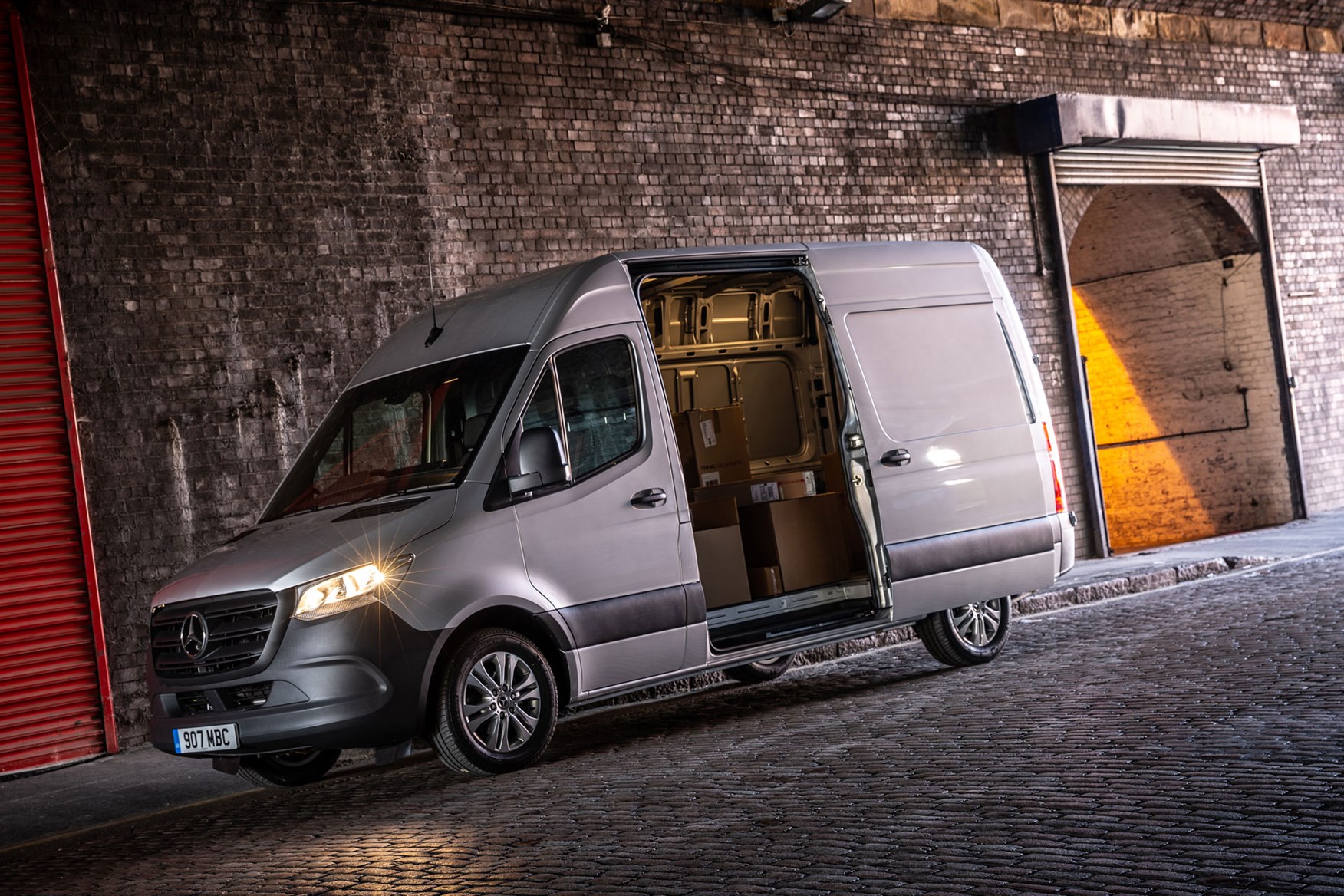
The standard 4G Wi-Fi connectivity and the Mercedes Pro Connect app means you can locate the vehicle easily – useful for big parking lots as well as recovery after a theft. The same system allows you to remotely lock (and unlock) doors, and see whether the doors and windows are closed.
Mercedes usually fits strong double locks, but as with any van, if someone really wants to get inside, they will – no lock can protect from mechanical cutting equipment, after all. Don’t leave anything inside that you can’t afford to lose.
Which Mercedes-Benz Sprinter is best for me?
With such a vast array of models and options, picking your perfect Sprinter might prove quite a task - though whatever you want one for it's likely Mercedes has something suitable.
Here is some extra info that might help you decide which is best for you.
Most popular Mercedes Sprinter engines
Most buyers are likely to choose the 140hp/143hp engine options, which will be fine in most circumstances.
However, we found that even without any load in the back at all, these will start to struggle on steep hills in top gear when equipped with the standard six-speed manual gearbox. The problem is present on both FWD and RWD versions.
So, either be prepared to start shuffling cogs with the gearlever in order to maintain momentum, or go for an automatic transmission.
Are FWD or RWD Sprinters better value?
Front-wheel drive Sprinters cost less, but may get through front tyres more quickly and they certainly require servicing more often.
Swings and roundabouts… We suggest you buy based on the best choice for your use. FWD Sprinters are nimble, and perhaps a tad nicer to drive; RWD Sprinters will cope with heavier loads, offer greater traction when fully loaded and are better for towing.
Mercedes Sprinter 4x4 review
Tested January 2019 by Tom Webster
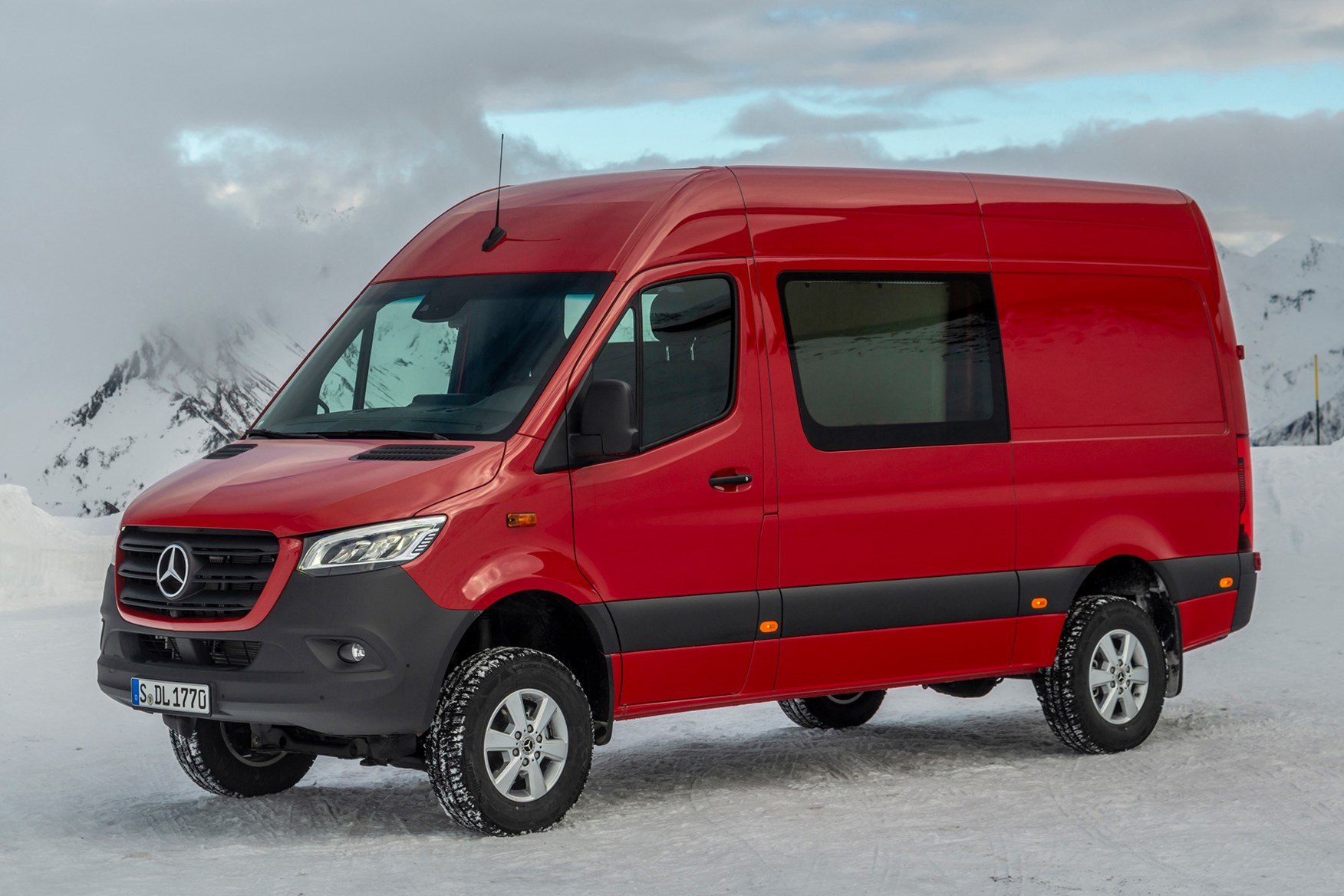
We’ve had an early drive in the go-anywhere version of Mercedes’ high-tech large van, the Sprinter. We travelled to the Austrian Alps to tackle icy terrain that is likely to be harsher than that faced by many Sprinters.
The new Mercedes Sprinter comes with so much technology that it offers almost anything a modern van user could want. But there was no four-wheel drive version.
Now a 4x4 model has joined the range though, and we've had an early go. So far, we’ve only been able to take the Sprinter 4x4 out on off-road terrain, however, that was about as testing as it gets, as snow and ice-covered mountain roads are likely to offer a sterner challenge than many Sprinters will face in the UK.
Doesn’t the Mercedes Sprinter 4x4 look a bit odd?
There is a chance that you will be able to spot a 4WD Sprinter from a long way off, thanks to the 100mm increase in ride height that gives it an elevated stance. It stops short of looking like it is perched on an unlikely set of automotive stilts, instead appearing more rugged and capable. As much as a panel van can look rugged that is – there isn’t any extra unnecessary cladding around the wheel arches, or enhanced bumpers.
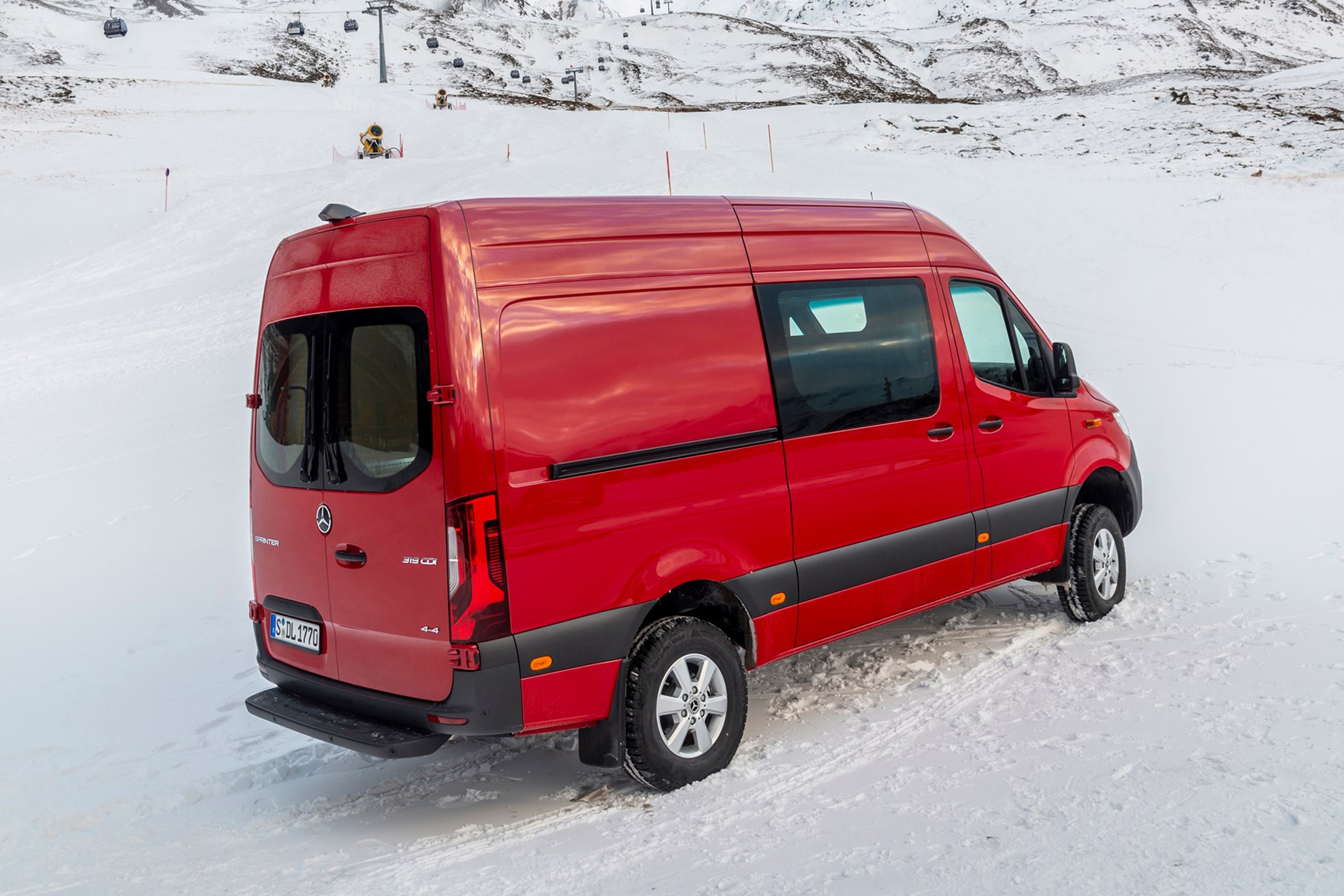
This is an optional addition, though, so there is every chance that you won’t be able to spot the 4WD Sprinter among its front-wheel-drive or rear-wheel drive compatriots.
If you do go for it, then taller drivers will be made to feel small when getting in and out of the cab. The extra ride height makes for a very high step up from the ground, so all but the very loftiest of drivers will have to make use of the side steps and the grab handles.
It is a shame that these handles are located on the door, though, rather than the windscreen pillar. The positioning doesn’t feel as natural for pulling oneself up into the cabin, so instinct has you reaching for the steering wheel to get a boost up. However, such is the height of the handle that there is every chance that would be out of the reach of some shorter drivers if it is was positioned there anyway.
What is the Mercedes Sprinter 4x4 like off-road?
The conditions we faced in the Sprinter 4x4 were certainly a test, with deep snow and ice proving a challenge. None of the Sprinters we tried, be it the 143hp four-cylinder 2.0-litre diesel or the more powerful V6, struggled with getting over the frozen obstacles, but the smaller version did have to work a fair bit harder to keep up with the passenger car leading us when we were on the longer uphill straights.
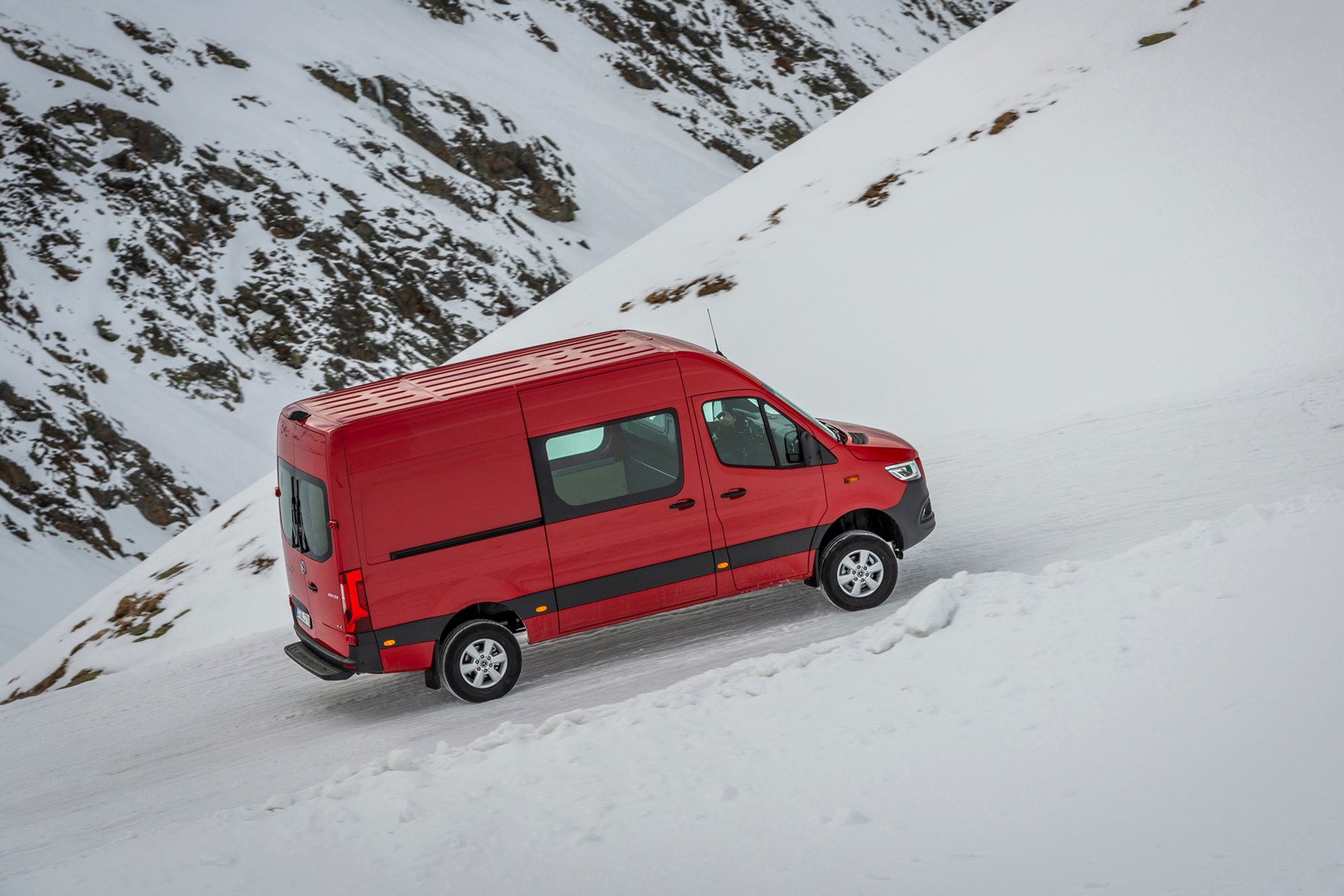
With so much extra height in the suspension, it is perhaps no surprise that the ride feels different to a standard Sprinter. Inevitably there is a little extra bounce and movement over bumps, but the big caveat is that we were unable to venture away from our mountain road, and certainly never got up to anything like motorway speeds.
Despite this extra bounce, it doesn’t ever feel like control is compromised, as most of the movement is absorbed long before it gets to the cabin. Whether this is the case on a rolling UK A-road with its fair share of potholes remains to be seen.
What other kit does the Mercedes Sprinter 4x4 come with?
The all-wheel drive Sprinter was a manual-only model in the past, but the good news is that this has changed with this latest version. Sadly, you don’t get the latest nine-speed automatic gearbox that is available on the front-wheel drive Sprinter, but you do get the still-excellent seven-speed version that comes on the rear-drive version.
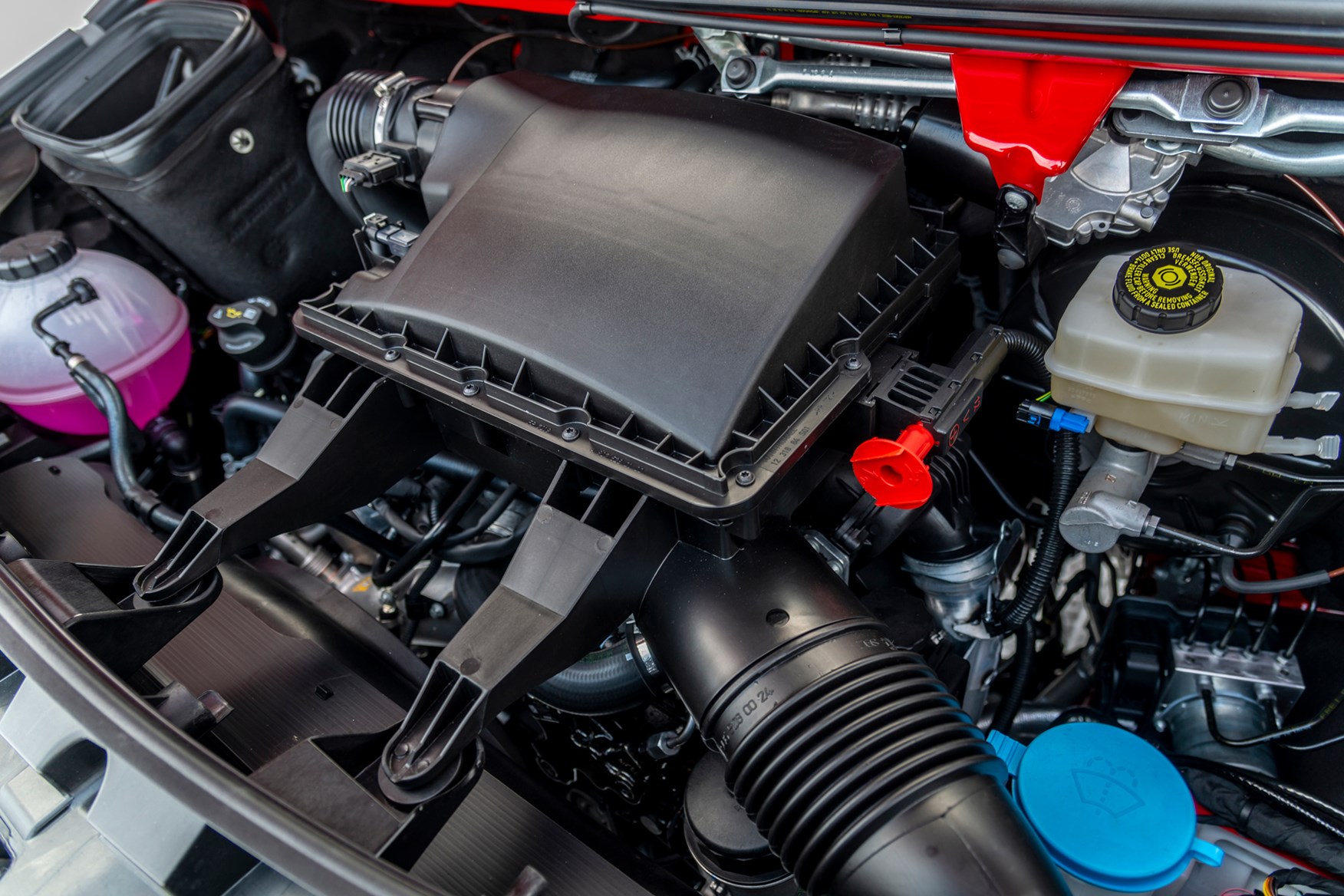
Despite not being the newest auto around, it is still a smooth and slick unit.
As with the RWD model, the 4x4 will only be offered as a 3.5-tonne version and above and there is a choice of three engines. There will be a choice between the 2.0-litre, four cylinder 143hp and 163hp diesels and the 190hp 3.0-litre V6 diesel.
Is the Mercedes Sprinter 4x4’s payload affected?
Adding the necessary mechanicals to send power to the back wheels inevitably adds weight, which then impacts on payload. The 4x4’s payload is approximately 200kg lower than that of the RWD model, which is in turn around 35kg lower than the FWD version.
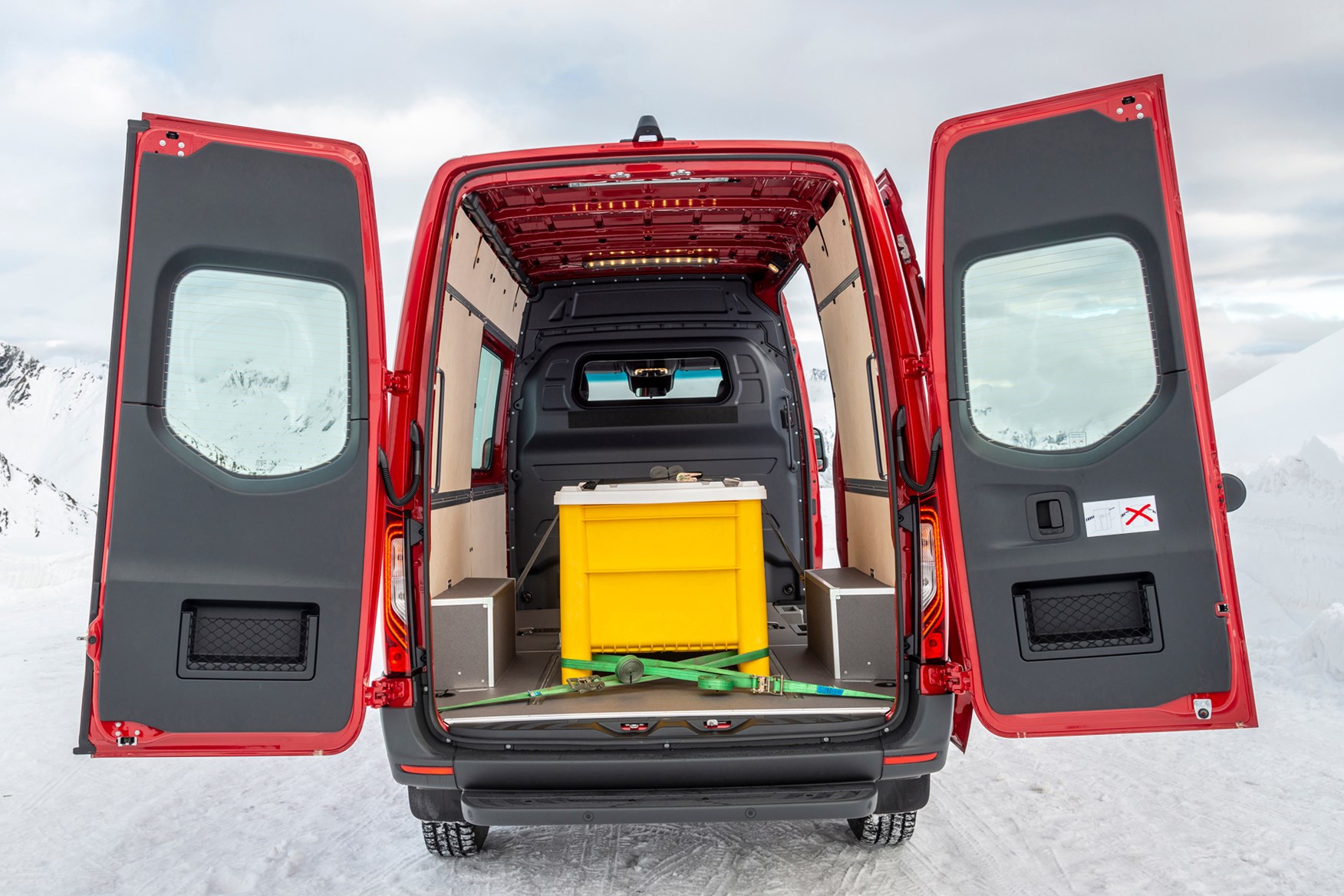
This would mean that the payload king – the 314 CDI – should still be capable of carrying around 1,220kg.
However, because the 4x4 version has been planned in from the start, the loading capacity isn’t affected.
When does the Mercedes Sprinter 4x4 go on sale and how much will it cost?
The final date is still to be confirmed, but we expect it to be available from February. Expect to pay a premium for sending power to all four wheels, though, with the 4x4 model likely to add around £7,000 to the cost of a 2WD model, meaning prices will start at around £37,000 (not including VAT).
More information is set to be announced in January, and we will bring you all the latest when it is available.
